Posts Tagged ‘koala habitat’
Saturday, October 12th, 2013
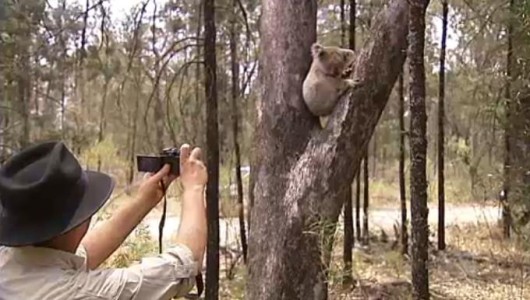 Ecological consultant David Paul with a koala found in the Leard State Forest
[Source: Photo by Tania Marshall, Front Line Action on Coal,
^http://frontlineaction.wordpress.com/] Ecological consultant David Paul with a koala found in the Leard State Forest
[Source: Photo by Tania Marshall, Front Line Action on Coal,
^http://frontlineaction.wordpress.com/]
.
Environmentalists are urging the New South Wales and Australian governments to save the Leard State Forest. They are concerned about the catastrophic impact of major mining expansion on an isolated and vulnerable koala colony in its natural habitat within the Leard State Forest.
The Leard State Forest is situated near Maules Creek within the Namoi River catchment about 10km north-east of the township of Boggabri on the North West Slopes of New South Wales, about 500km nor’-nor’-west of Sydney.
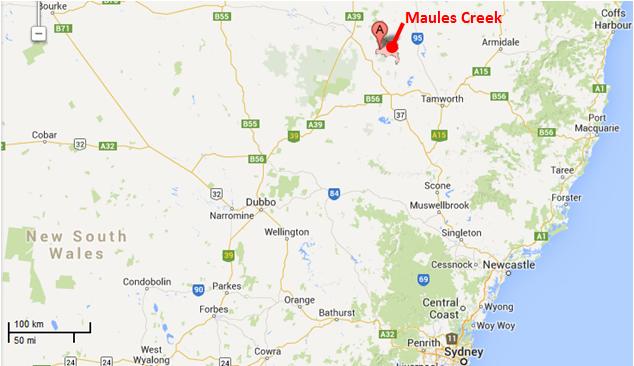 Maules Creek Mine location map
[Source: Google Maps] Maules Creek Mine location map
[Source: Google Maps]
.
The nearby town of Boggabri lies on the Namoi River, a major perennial river and floodplain within the Murray-Darling Basin. The landscape is naturally subjected to infrequent seasonal rains and widespread flooding.
.
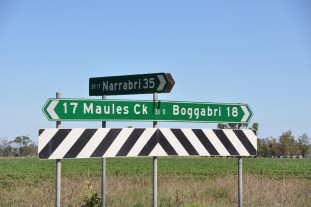 . .
The native vegetation has been naturally dominated by Box-Gum Woodland ecological communities featuring the endemic species of White Box, Pilliga Box and Bimble Box. These provide vital habitat for numerous woodland bird and microbat species and a small community of Koalas.
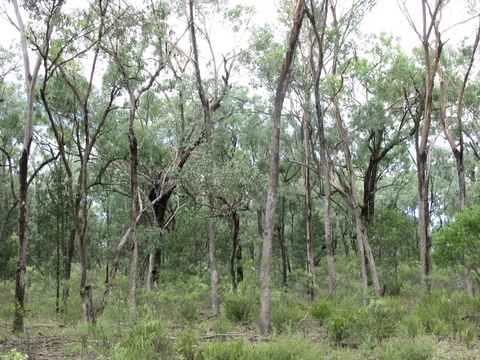 The Leard State Forest
An isolated remnant box woodland The Leard State Forest
An isolated remnant box woodland
.
The region was originally the Aboriginal land of the Kamilaroi people and their ‘place of many creeks‘. However, two hundred and twenty five years of colonial pastoral settlement and associated widespread deforestation has seen the region denuded of most native vegetation historically for sheep and wheat; and more recently for irrigated cropping, particularly water thirsty cotton.
.
 Box Woodland decimated for industrial scale cotton
The farming model is entirely artificially dependent river-diverted irrigation for export produce.
[Source: Promotional tourism advertisement by the NSW Government,
^http://www.visitnsw.com/destinations/country-nsw/moree-and-narrabri-area/gallery] Box Woodland decimated for industrial scale cotton
The farming model is entirely artificially dependent river-diverted irrigation for export produce.
[Source: Promotional tourism advertisement by the NSW Government,
^http://www.visitnsw.com/destinations/country-nsw/moree-and-narrabri-area/gallery]
.
Native habitat has been sadly reduced to a few isolated islands of land set aside as ‘State Forests’. These include the Pilliga Forest, the largest remnant temperate forest in Eastern Australia, as well as Jacks Creek, Plagyan, Rusden and Leard State Forests, as well as the rugged Mount Kaputar National Park.
Leard State Forest includes the most extensive and intact stands of the nationally listed and critically endangered Box-Gum Woodland remaining on the Australian continent and is home to nearly 400 native species of plants and animals, and includes habitat for 34 threatened species and several endangered ecological communities.
.
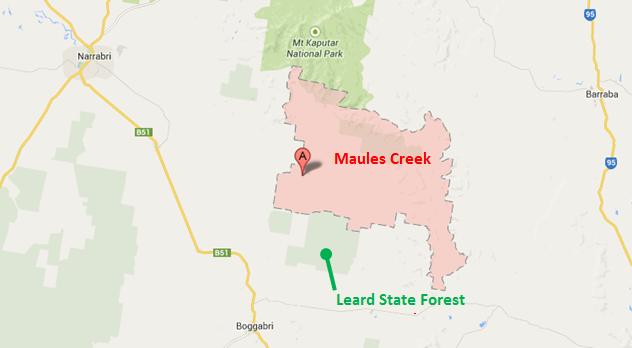 Leard State Forest location map
[Source: Google Maps] Leard State Forest location map
[Source: Google Maps]
.
It’s believed as few as 20 koalas are left in the Leard State Forest, which is considered its primary habitat. The primary food source for the koalas is thought to be the Pilliga Box, Red Gums and Yellow Boxes. This Koala population is very fragile and could be significantly impacted on by the future mining plans.
Ecological consultant David Paul:
“If they are part of the same population as the Pilliga koala, then Leard is a very important area for allowing the dispersal of these animals in an east west direction. Leard Forest is a stepping stone between habitat in the Pilliga and to the east and south. While there are not many koalas there it’s a very important area to allow the dispersal of koalas in the region.”
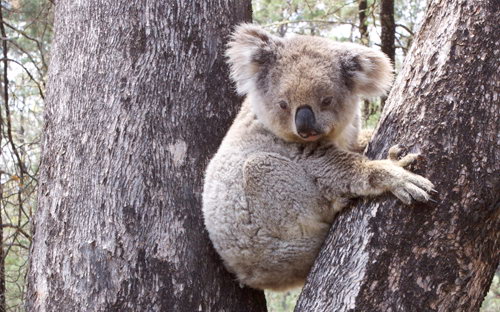 Koala in Leard State Forest
[Source: Photo by Tania Marshall, Front Line Action on Coal,
^http://frontlineaction.wordpress.com/] Koala in Leard State Forest
[Source: Photo by Tania Marshall, Front Line Action on Coal,
^http://frontlineaction.wordpress.com/]
.
.
Whitehaven Coal mining expansion into the Leard State Forest
.
<< Approval has been given for one of the biggest open-cut coal mines in the world in the state’s north-east. Whitehaven’s Maules Creek Project, near the Leard State Forest, will extract 12 million tonnes of raw coal a year.
If given the final go ahead from the Federal Government, Whitehaven expects production to start mid-2013, with operations predicted to last around 30 years.
Managing director Tony Haggarty:
“The mine will be good for the region economically and good for the state. It’s one of the best coal developments in the world. It’s a large reserve, it’s very good quality. It’s the sort of coal that is in demand in the market place, and because the reserve is large and because it has a long life, there will be a significant area of land involved.”
.
But Federal Environment Minister Tony Burke says the project will now face Commonwealth scrutiny. It will examine the mine’s potential impacts on the nearby critically endangered white box woodland.
An Environment Department spokeswoman says once the assessment is complete, it will go before Mr Burke who will consider the advice of the department, the Independent Expert Scientific Committee on possible water impacts, and any public comments.
Environmentalist Phil Spark:
“The planning commission’s approval is a blow to the endangered trees and animals that live in the forest. My biggest concern is that the environment has been totally undervalued. You just can’t destroy a forest and think it’s going to be compensated. It’s an endangered ecological community and it just can’t be replaced.”
The Maules Creek Project is about 18 kilometres north of Boggabri in the Gunnedah Basin. >>
.
[Source: ‘Go ahead for one of world’s largest coal mines’, 20121025, ^http://www.radioaustralia.net.au/international/2012-10-25/go-ahead-for-one-of-worlds-largest-coal-mines/1035960]
.
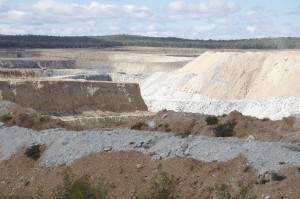 Nearby Boggabri Open Cut Coal Mine, owned by Whitehaven Coal
Saw thousands of hectares of native Box Woodland bulldozed in 2006. Nearby Boggabri Open Cut Coal Mine, owned by Whitehaven Coal
Saw thousands of hectares of native Box Woodland bulldozed in 2006.
.
Environmentalists are up in arms over a proposal to mine two thousand hectares of state forest, among it, this remnant koala habitat.
The Maules Creek Mine adjoining the Leard State Forest has received NSW government approval to expand into the forest, which will see most of the forest and its flora and fauna all but completed bulldozed into history.
Whitehaven Coal wants a new open-cut coalmine that will extract up to 13 million tonnes of coal a year to earn it $767 million. It also wants a second nearby Idemitsu Boggabri open cut mine to extract 7 million tonnes a year.
Greens Senate Candidate Cate Faehrmann:
“These approvals will literally change the face of the township of Gloucester as well as the small community of Maules Creek near Narrabri in the state’s north-west. The Maules Creek and Boggabri proposals were referred to the Federal environment minister Tony Burke because they are going to wipe out critically endangered forest which is home to many threatened species. How can any Environment Minister in their right mind approve this?
The Maules Creek coal mine alone will emit the same amount of carbon emissions each year as New Zealand during its proposed 30 year life span. This is disgraceful and it’s why communities everywhere are starting to call on the government to transition away from coal and towards a secure renewable energy future.
I have visited the site of the proposed Maules Creek coal mine recently to see the forest firsthand and saw a koala up close in the forest. Tony Burke has just approved a coal mine which will wipe out a small and vulnerable koala population
“The farmers who have been fighting coal mine proposals in Leard State Forest for years will continue to fight for the protection of their forest.”
.
Up until recently, Whitehaven Coal has been owned by multimillionnaire Nathan Tinkler. Its chief executive is Paul Flynn and one of its directors is former National Party leader Mark Vaile. In June 2013, after securing his Maule’s Creek Mine expansion approval, Tinkler sold off most of his shareholdings in Whitehaven Coal to an American profiteering investment capital firm, Farallon Funds.
Whitehaven Coal has been challenged in the courts against its proposal to mine the Leard State Forest by the Northern Inland Council for the Environment. This community based not-for-profit group has said the Federal government was wrong to approve the project. They are challenging the approval process of both the Maules Creek and nearby Idemitsu Boggabri coalmines “because of the dodgy process by which they were approved and the devastating impacts they will have”.
Whitehaven Coal chief executive Paul Flynn has insisted the court challenge to the approval of the Maules Creek mine in NSW will not stop the project and is merely a “frustrating niggle“.
Last financial year Whitehaven made a loss of $82 million.
.
[Sources: ‘Whitehaven carries on with project despite legal challenge’, 20130720, by Michael Hobbs and AAP, ^http://www.afr.com/p/national/whitehaven_carries_on_with_project_z0EwnCKbgJE1Xnrp3wJVoO; ‘Whitehaven Coal falls to $82m loss’, 20130827, by Greg Roberts, Sydney Morning Herald, ^http://news.smh.com.au/breaking-news-business/whitehaven-coal-falls-to-82m-loss-20130827-2sndo.html; ‘Tinkler sells out of Whitehaven’, 20130619, by Glenda Kwek, Sydney Morning Herald, ^http://www.smh.com.au/business/mining-and-resources/tinkler-sells-out-of-whitehaven-20130619-2ohnj.html; ‘Mining proposal puts koala habitat under threat’, 20121109, by Liv Casben, ABC media, ^http://www.abc.net.au/news/2012-11-09/mining-proposal-puts-koala-habitat-under-threat/4363234; ‘Concern for Koala’s in the Leard State Forest’, 20121112, by Kelly Fuller, ABC media, ^http://www.abc.net.au/local/audio/2012/11/12/3630754.htm; ‘Labor turns back on NSW environment’, 20130211, by Cate Faerhmann, ^http://catefaehrmann.org/tag/mining/]
.
Listen to ABC Radio interview with Ecologist David Paul in 2012:
 (Click icon and play audio on the ABC Radio website, turn up volume to listen)
[Source: ‘Concern for Koala’s in the Leard State Forest’, 20121112, radio interview by Kelly Fuller, Morning Show, ABC Radio New England NSW,
^http://www.abc.net.au/local/audio/2012/11/12/3630754.htm] (Click icon and play audio on the ABC Radio website, turn up volume to listen)
[Source: ‘Concern for Koala’s in the Leard State Forest’, 20121112, radio interview by Kelly Fuller, Morning Show, ABC Radio New England NSW,
^http://www.abc.net.au/local/audio/2012/11/12/3630754.htm]
.
.
.
Further Reading:
.
[1] Front Line Action on Coal, (a community-based environmental activist group), ^http://frontlineaction.wordpress.com/
.
[2] ‘Koala habitats in danger as bushland areas are bulldozed‘, 20121011, Sydney Morning Herald, ^http://www.smh.com.au/environment/animals/koala-habitats-in-danger-as-bushland-areas-are-bulldozed-20121011-27fjw.html
.
[3] ‘Mining proposal puts koala habitat under threat‘, 20121109, ABC News, ^http://www.abc.net.au/news/2012-11-09/mining-proposal-puts-koala-habitat-under-threat/4363234
.
[4] ‘Burke approves huge gas and coal plans‘, 20130212, by Ben Cubby, Paddy Manning, Sydney Morning Herald, ^http://www.smh.com.au/federal-politics/political-news/burke-approves-huge-gas-and-coal-plans-20130211-2e8vh.html
.
<< A clutch of big coal and coal seam gas projects, including the controversial Whitehaven mine near Narrabri in NSW, have been approved by the federal Environment Minister, Tony Burke. He signed conditional approvals for Whitehaven’s Maules Creek mine, planned for the Leard State Forest, Idemitsu’s neighbouring Boggabri coalmine expansion, and a coal seam gas development planned by AGL for Gloucester in NSW.
Together, the three resources projects would have a huge carbon footprint of 47 million tonnes of greenhouse gases a year – about 8 per cent of Australia’s total emissions – according to environmental impact assessments. Whitehaven, part-owned by embattled coal baron Nathan Tinkler, was subject to a damaging hoax when anti-coal campaigner Jonathan Moylan issued a fake press release claiming ANZ had stopped funding the project, causing a temporary drop in the miner’s share price. His protest is being investigated by the Australian Securities and Investments Commission.
The mining projects had all been approved at state level. Mr Burke’s signature was seen as the final obstacle to development.
”Of all the decisions I have ever made, this is the one where I have the least idea of whether the projects are going to go ahead,” he said. ”For all three projects there are substantial issues.”
Some of the hurdles yet to be overcome are the preservation of a ”biodiversity corridor” in the Leard Forest to allow koalas and other vulnerable animals to survive, high quality offsets to partially compensate for sections of the forest which would be cut down, and a hydrogeological survey around Gloucester.
Mr Burke compared Monday’s decision to the approval granted by former environment minister Malcolm Turnbull to the proposed Gunns pulp mill in Tasmania. That process involved a series of separate ”modules” that stretched the approvals process out for years, before the project was finally canned.
Asked if his coal and coal seam gas decisions then amounted to ”Clayton’s approvals”, Mr Burke said: ”It’s a completely fair criticism. I would have much preferred to do things in the usual way, and give clear approvals or rejections. Unfortunately the NSW government chose to leak commercial information, and caused this process.”
Mr Burke was referring to a confidential letter from him to the NSW government, obtained by Fairfax Media, flagging his intention to approve the Whitehaven mine late last year. He said NSW would be excluded from the further approvals process because the letter was leaked.
Also on Monday, the NSW government granted conditional approval for an expansion of BHP Billiton’s Dendrobium coalmine south-west of Sydney. Five longwall coal panels will be dug beneath Sydney’s drinking water catchment, with some surface damage expected to eight ”upland swamps” – rare ecosystems that support a variety of plants, birds and amphibians.
The managing director of Whitehaven, Tony Haggarty, welcomed the approval and said: ”Notwithstanding the stringent environmental conditions which have been placed on the project and the difficult coal market at present, this is an excellent project and Whitehaven will be seeking to bring it into production as soon as possible.”
An AGL spokeswoman also welcomed the approval and said it would work on satisfying the 36 conditions on matters of national environmental significance and protection of groundwater.
”Conservationists are furious about Minister Burke’s decision,” said the chief executive of the Nature Conservation Council of NSW, Pepe Clarke. ”Leard Forest is a rich natural habitat, teeming with life, and this decision marks the death knell of this extraordinary area.” The NSW Greens said the series of approvals made for ”a very black day for the environment in NSW”. >>
.
[5] ‘Whitehaven Coal gets Maules Creek green light‘, 20130926, The Australian Newspaper, ^http://www.theaustralian.com.au/business/mining-energy/whitehaven-coal-gets-maules-creek-green-light/story-e6frg9df-1226727476581]
.
[6] ‘Leighton to build Maules Creek rail loop‘, 20131010, Sydney Morning Herald, ^http://news.smh.com.au/breaking-news-business/leighton-to-build-maules-creek-rail-loop-20131010-2v9ic.html,
.
<< Whitehaven Coal has contracted Leighton Holdings to build a rail loop for its $766 million Maules Creek project in NSW. The rail loop is a key part of the coal mine’s infrastructure and an important milestone in its construction, Whitehaven said.
The mine, in the Gunnedah basin in the state’s north, is slated to begin production in the first quarter of calendar 2015, providing 10.5 million tonnes of saleable thermal and coking coal.
Environmentalists are fighting the federal government’s approval of the mine in the Federal Court, with a decision expected in November. >>
.
[7] Maules Creek Community Council, ^http://maulescreek.org/
.
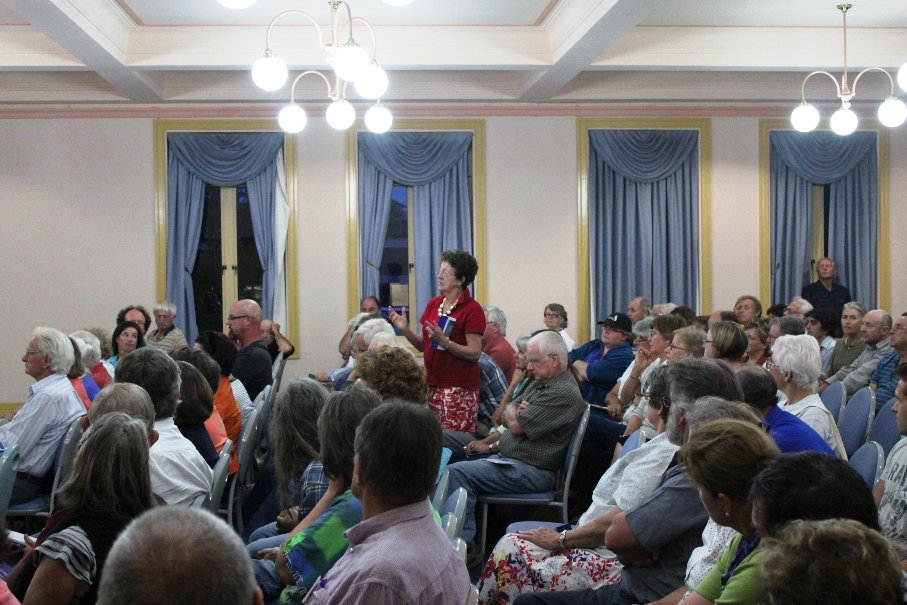 Community protest meeting against local coal mining
[Source: ‘Sea of hands support gasfield free region at Tamworth public meeting’, 20130226,
^http://maulescreek.org/news/page/3/] Community protest meeting against local coal mining
[Source: ‘Sea of hands support gasfield free region at Tamworth public meeting’, 20130226,
^http://maulescreek.org/news/page/3/]
.
[8] Whitehaven Coal – the dirty face of the Coal Industry

Whitehaven Jobs: << With a workforce which will surpass 1000 people in the next five years, we are the place for opportunity. We are independent, we have a high quality portfolio of producing mines and we are developing three of Australia’s most significant new coal projects.
We want smart, committed, motivated people who value a dynamic culture and quick decision making. We want people who value being part of a community and achieving goals. At Whitehaven people can make a difference, and do make a difference. Our operations are currently underpinned by our Narrabri underground longwall operation and our three existing open cut mines – all situated in NSW’s Gunnedah Basin.
Our Maules Creek Project, also in the Gunnedah Basin, was fully approved in July 2013 and will provide significant and exciting career opportunities across a wide range of mining-related professions. Maules Creek is one of the last major undeveloped and significant multi-seam coal deposits in New South Wales and is expected to sustain a potential project life in excess of 30 years. It is approved to extract up to 13 Mt of coal per annum and rail 12.4 Mt of product from the site in any calendar year.>>
[Source: <<http://www.whitehavencoal.com.au/careers.cfm]
.
[8] ‘Icons under threat‘, Nature Conservation Council of New South Wales, 2012, report, ^http://nccnsw.org.au/content/icons-under-threat
.
Tuesday, November 27th, 2012
 Shrinking Koala Habitat – completely dependent upon the whims of Australians, if we give a toss. Shrinking Koala Habitat – completely dependent upon the whims of Australians, if we give a toss.
Being systematically destroyed by O’Farrell Government Loggers across coastal New South Wales, Australia
.
Koala Habitat is being trashed across New South Wales
[Source: The following article was published as ‘When trees fall in the forests’, by Ben Cubby, Sydney Morning Herald, 20101112, ^http://www.smh.com.au/environment/conservation/when-trees-fall-in-the-forests-20101111-17pgt.html]
.
<<The dull, grinding roar of logging trucks has become background noise in the hills around Eden, on the New South Wales south coast. Equally familiar is the sight of people photographing the loggers’ loads as they are hauled down to the local woodchip mill and on to ships bound for Japan. The campaigners are looking for signs of tree trunks that have hollows and may have supported native sugar gliders or owls.
About 1,200 kilometres north, in the subtropical rainforest near Casino, botanists and zoologists are poring over maps and Google Earth, tracking breaches of logging conditions – trees cut down inside protection zones, trees felled that supported endangered wildlife or nourished other flora.
The tit-for-tat battle in the forests has led to frustration on all sides, with forestry workers complaining of ”manic hatred” directed at them. Anti-logging activists say the damage to state forests is systematic and routine, as established rules in the NSW Forest Agreements are disregarded.
”It’s not exactly a surprise to us that there are so many breaches because the fox is in charge of the hen house,” says Lisa Stone, a campaigner with South-East Forest Rescue. ”It keeps happening over and over again. You have got areas where they are supposed to be taking out single trees and then you go there and it’s practically clear-felled.”
For each state forest targeted for logging, a plan must be drawn up that leaves some trees untouched, in accordance with the ”environmental protection licences” issued to logging contractors working for the state government agency, Forests NSW.
.
What the hell is Government’s Forests NSW doing to Wildlife Habitat?
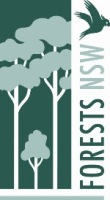
Forests NSW Greenwash:
.
“Forests NSW is committed to ensuring a supply of timber from NSW State forests today and into the future while also protecting other forest values such as biodiversity, clean air and water and public access for recreation. We are committed to running a safe and profitable business for the people of NSW.”
“The NSW (O’Farrell) Government has announced it will make Forests NSW a state owned corporation (SOC). Forests NSW will remain publicly owned and the nature of the business and business relationships will remain largely the same but the governance structures will change to improve the organisation’s commercial performance.
As a state owned corporation under the direction of a skilled commercial board, Forests NSW will be able to focus sharply on its core business of growing and harvesting timber to meet the community’s needs for hardwood and softwood products while still providing recreational opportunities for the people of New South Wales.”
[Source: ^http://www.forests.nsw.gov.au/]
.
Ed: So to the O’Farrell Government the forests are only about human needs – a babyboomer mindset, just like in the Old Testament. “..And God said unto them be fruitful, and multiply, and replenish the earth, and subdue it: and have dominion over the fish of the sea, and over the fowl of the air, and over every living thing that moveth upon the earth.” [Bible, Old Testament, Book of Genesis 1:28] ..and humans have been self-righteously buggering the planet ever since.
.
<<The many-layered oversight system produces a lot of work for the handful of NSW Department of Environment, Climate Change and Water staff, some of whom have found themselves visiting the same logging sites repeatedly.
Forests NSW stressed that a warning letter can refer to separate breaches, which partly explains why the number of warnings issued to Forests NSW is so much lower than the number of times rules get broken.
Nonetheless, department staff have told the Herald that guidelines are often applied indifferently by loggers and some contractors are serial offenders. Forests NSW has also lost staff through voluntary redundancy this year which, some workers argued, affects its ability to police logging contractors.
A spokeswoman for the Environment Department said logging licences contained ”strict provisions to protect the environment, threatened species and its habitat”. Audits of logging operations are carried out every month as part of its compliance program.
”[The department] is concerned about the number of recent alleged breaches being reported in the south-east of NSW and in response is conducting several comprehensive field audits of Forests NSW work in the region. If any of the alleged breaches are found to be substantiated then the [department] will take appropriate action.”
New spice has been added to the deluge of investigations by the recent so-called ”peace deal” in Tasmania, which saw major logging companies, including Gunns, agree to stop logging in old-growth native forests. The deal also included an effective end to large-scale burning of native timber as a source of renewable energy, a process that is now permitted in NSW. The National Association of Forest Industries said it would oppose any effort to transfer the Tasmanian deal to mainland Australia.
A woodchip company, South-East Fibre Exports, is planning to build the state’s first wood-fired electricity plant at Eden, burning ”offcuts”. The company says opposition to its power plant is driven by people with the broader agenda of ending logging in native forests altogether. This seems likely to be true. South-East Fibre Exports blames anti-logging campaigners for setting up a fake website that mocks the company’s proposal, and a campaigner against the power plant, the former fashion designer Prue Acton, found an electronic bugging device in her home earlier this year. No one knows who is responsible for planting the bug, and there is no suggestion it is linked to the logging dispute. Police are investigating.
The NSW Primary Industries Minister, Steve Whan, said he had faith in the forestry companies and Forests NSW. ”Allegations of ‘systematic damage’ are overstated,” says Whan. ”The majority of the alleged breaches in question are minor in nature – with little to no impact on the environment.”
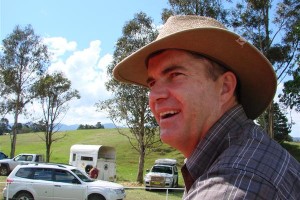 Former NSW Labor Minister for Minerals and Forest Resources, Steve Whan,
who also had Primary Industries, Emergency Services and Rural Affairs – i.e. politically imposed conflicts of interests. Former NSW Labor Minister for Minerals and Forest Resources, Steve Whan,
who also had Primary Industries, Emergency Services and Rural Affairs – i.e. politically imposed conflicts of interests.
.
In southern NSW, the forestry organisation is regularly scrutinised and was operating within the rules.
”Forests NSW southern region has received no penalty notices and not one case has been brought to prosecution for at least the past three years. ‘As a local member in the area as well as the Minister for Forest Resources, I personally welcome the intense environmental scrutiny that forestry operations in the area are subjected to. It is very important that any logging operations in the region comply with all the environmental conditions in place.”
Documents maintained by Forests NSW staff show there were 13 breaches recorded in south-eastern NSW last year.The breaches include cases of ”lack of care taken by operator”, ”operator did not see marking tape” and ”poor rigour in completing surveys”. Some could be explained by mishaps such as a vehicle slipping on a steep hillside into a protected area. In one case a logging contractor cut down trees in an area marked as ”old growth forest” because a global positioning system device had run out of batteries.
Of the 13 recorded incidents, eight resulted in verbal warnings to forestry contractors and one, in which the estimate of damage made by environment department staff differed from Forests NSW’s, resulted in a warning letter. Environmental damage was in every case assessed to be ”nil” and no remedial action was taken.
In part, the mistakes could be put down to forestry workers working to tight deadlines in rugged terrain.
But anti-logging activists are not prepared to be that charitable. The parallels with the situation in northern NSW are remarkable. In the state forests around Casino and Tenterfield, a group called North-East Forest Alliance has identified damage to stands of trees inhabited by koalas, stuttering frogs, sooty owls, powerful owls, golden-tipped bats and yellow-bellied gliders. The same types of breaches are evident, with contractors failing to follow guidelines about properly marking up vulnerable trees. Trees up to two metres wide at the base were cut down inside an area of rainforest described as a ”special protection zone”.
Five sets of allegations, covering dozens of alleged individual breaches in separate forests, were sent to the Environment Department early this year. Staff undertook a joint investigation with the forestry agency, and Forests NSW said a ”compliance response team” had been established.
South-East Forest Rescue recently surveyed state forests at Mogo, near Batemans Bay, and found recent logging in areas that were supposed to have been preserved, including an Aboriginal cultural site and conservation areas. In a report sent to the government, it alleges that many hectares of forest that should have been off-limits to loggers had been cleared.
The group has also walked through south coast state forests Tantawangalo, Yambulla, Glenbog and Dampier, collecting photographs of logging sites. Earlier surveys of the various regions by the Environment Department show habitat supporting sooty owls, yellow-bellied gliders, square-tailed kites, giant burrowing frogs, bent wing bats, tiger quolls, glossy black cockatoos and powerful owls may have been damaged.
The group’s surveys have been passed on to the Environment Department. The department said its own studies in the area are expected to run until mid-November. Stone says the group wanted Whan to visit the logging locations they had surveyed.>>
.
.
Koala habitat faces bulldozing in Victoria
[Source: ‘Super-koala’ habitat faces bulldozing, by Claire Miller, 20051002, ^ http://www.theage.com.au/news/national/superkoala-habitat-faces-bulldozing/2005/10/01/1127804696947.html]
 Susie Zent in the area slated for road-widening 2005 Susie Zent in the area slated for road-widening 2005
(Photo: Cathryn Tremain)
.
South Gippsland (2005):
.
<<Critical habitat supporting the so-called Strzelecki “super-koala” and endangered powerful owls is to be bulldozed as part of a controversial road-widening project in South Gippsland.
Several hundred trees, many home to koalas and with hollows suitable for nesting owls and other wildlife, will be lost, despite consultants warning the Latrobe City Council that the damp forest habitat is virtually irreplaceable in a region largely cleared of native vegetation.
The local member for Morwell, Brendan Jenkins, is appealing to Environment Minister John Thwaites for an 11th-hour reprieve after local conservationists lost their case in the Victorian Civil and Administrative Tribunal.
Latrobe Council wants to widen Budgeree Road so that logging trucks servicing plantations can pass each other. Trucks now travel one way down the road and return via another route. Budgeree Road is also a tourist drive to Tarra Bulga National Park.
The tribunal initially raised strong objections to the project, near Boolarra, in the face of evidence that the council took little account of the vegetation affected, that traffic volumes did not justify the scale of the works, and that a redesign could save most trees. Then, in a surprise turnaround, it approved the project last month with minor amendments.
.
‘Strzelecki koalas are a genetically superior group that may hold the key to the species’ long-term survival in Victoria.
All other koalas in the state are descended from a handful of individuals transferred to French Island more than a century ago, a few years before koalas were hunted to near-extinction on the mainland.’
.
Ed: This is a ecological cry of impending Koala regional extinction and a representative indictment of Australia’s deliberate and evil extermination of its wildlife.
.
The French Island colony was used to repopulate the state, but inbreeding is now becoming apparent. The Strzelecki koalas, however, appear to be a remnant of the original and genetically diverse mainland population.
The roadside forest is rare in its own right, being of “very high conservation significance”. This category has legislative protection under the Native Vegetation Management framework, and can be cleared only under exceptional circumstances.
The loss of hollow-bearing trees is also listed as a threat under the Flora and Fauna Guarantee Act. Consultants from Biosis Research told Latrobe Council it would be difficult to find other damp forest areas that could offset the loss of roadside remnants.
Susie Zent, from Friends of the Gippsland Bush, said VCAT had set conditions for the roadworks based on a mistaken classification by the Department of Sustainability and Environment as to the vegetation’s significance. She said the VCAT decision could be set aside if the department admitted to an error of judgement and requested amendments to its permit conditions.
Latrobe’s chief executive officer, Paul Buckley, said he expected VicRoads to sign off the final plans within three or four weeks. He said the additional width was needed to improve safety.
A spokesman for Mr Thwaites said the department was waiting for final details from the council, particularly in relation to offset measures. “Offset measures are required to ensure there is no overall loss of areas that have ecological significance,” he said.>>
.
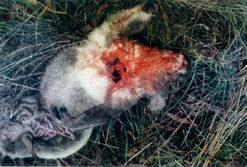 Strzelecki Koala Endangered
(South Gippsland Victorian, Australia) Strzelecki Koala Endangered
(South Gippsland Victorian, Australia)
.
<<Of major concern due to the logging and clearing activities of both Hancock Timber Resource Group and PaperlinX is the long term survival of populations of the Strzelecki and South Gippsland Koalas whose entire habitat is now owned by these companies.
An investigation carried out by Dr Bronwyn Houlden, School of Biological Science, University of New South Wales, 20th March 1997 and 6th April 1998 confirmed that the genetic pool of these koalas has not been compromised. Dr Houlden indicates that on a national basis koalas generally are not considered to be threatened. She advises that this assessment has unfortunately led to an extremely simplistic view of conservation of biodiversity in the species.
Through extensive analysis by herself and her collaborators she has revealed that the species is composed of highly differentiated populations with low levels of gene flow between populations throughout their range. The Strzelecki Koala population constitutes a separate management unit and is significant in terms of management of biodiversity on a regional and state basis. Dr Houlden found that the Strzelecki Ranges had the highest level of genetic variation, of any Victorian population she has analysed. This is important, given the low levels of genetic variability found in many populations in Victoria, which have been involved in the translocation program.>>
.
[Source: ‘Strzelecki Koala Endangered’, Hancock Watch (conservation group), ^http://hancockwatch.nfshost.com/docs/koala.htm#content_top]
.
.
The Critical Habitat Truth behind Hancock Timber Resource Group
.

Foreign-owned and controlled Hancock Timber Resource Group, claims publicly that its Victorian timber plantation operation, Hancock Victorian Plantations (HVP) is committed to…
“environmental responsibility is underpinned by the company’s environmental policy and management system, forest stewardship program, best management practices, which include internal and external performance measures, and active community consultation program, working with groups such as Landcare, field naturalists and Waterwatch.”
.
Hancock Victorian Plantations claims…
“HVP sets its own high standards, its operations are monitored by local shires, water catchment management authorities, the Environment Protection Authority (EPA) and the Victorian Department of Environment and Sustainability. The company is also subject to regular audits to maintain its Australian Forestry Standards (AFS) and Forest Stewardship Council (FSC) certifications.”Around 70 per cent of HVP’s total landholdings are sustainably-managed plantations, growing largely on land that was previously cleared for farming. The company maintains the remaining 30 per cent of its holdings for plantation protection, conservation and other community values.In the Strzelecki Ranges, HVP has set aside almost half of its land from timber production, managing this native forest for conservation.”
[Source: ^http://www.hvp.com.au/environment-conservation]
.
Editor: It all sounds wonderful coming from this United States industrial logger. But since when has anyone trusted US corporations? Read the snapshot log below.
.
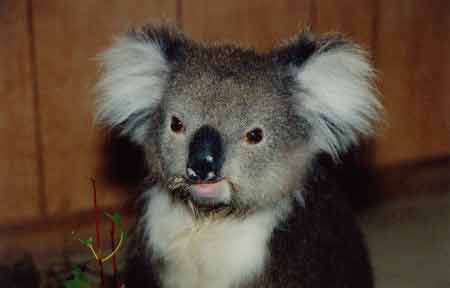 Road hit female koala with broken jaw. Had to be euthanised after 6 weeks.
Urgent research is required to determine breeding populations, location and numbers. Logging seriously impacts on long term populations of this animal.
[Source: Hancock Watch, ^http://hancockwatch.nfshost.com/docs/koala.htm#content_top] Road hit female koala with broken jaw. Had to be euthanised after 6 weeks.
Urgent research is required to determine breeding populations, location and numbers. Logging seriously impacts on long term populations of this animal.
[Source: Hancock Watch, ^http://hancockwatch.nfshost.com/docs/koala.htm#content_top]
.
.
Snapshot of a month’s logging of Koala Habitat:
[Source: ^http://hancockwatch.nfshost.com/docs/04sep.htm ]
.
South Gippsland, Victoria (October 2002) – systematically being destroyed for corporate profit by United States multi-national ‘Hancock Timber Resourse Group’:
.
Jeerlang West Road Strzelecki Ranges
- Locals outraged by removal of native vegetation – Koala Feed Trees. Koala corridor destroyed. Koalas are now not sited in this area. 8 Koalas have died in this area in the last 12 months.
.
Strzelecki Ranges (Jeeralangs)
- Eucalypts globulus – Bluegum (4ssp.) Southern Blue Gum – subspecies globulus. Restricted on the mainland to South Gippsland and Otways. Road works resulted in logging of older trees. Prime koala habitat destroyed by Grand Ridge Plantations/Hancock. A recent change in management will hopefully result in the end of this type of practice.
.
Strzelecki Ranges (Jeeralangs)
- Prime koala habitat destroyed without permit application by Grand Ridge Plantations/Hancock. Destruction of the rare Globulus globulus.
.
93-41 Creswick plantations
- Creek crossing over Anderson’s Gully which feeds into Creswick Creek. Tullaroop Water Catchment. Drinking water for Maryborough, Carisbrook, Talbot, Adelaide Lead, Alma, Havelock, Majorca and Betley. Sediment enters waterways mainly via creek crossings and roads.
.
93-41 Petticoat Plantation
- Tributary of Anderson’s Gully in the headwaters of the Murray Darling Catchment (Loddon River). Logging machinery driven straight through creekline.
.
93-41 Petticoat Creek
- Closeup of machinery entering tributary of Anderson’s Gully in the Tullaroop Water Catchment. Note build up of sediment which will wash into gully after rain. Note also buildup of stagnant water.
.
93-41. Petticoat Plantation
- Tullaroop Proclaimed Water Catchment. Machinery access into Anderson’s Gully tributary.
.
Morwell River East Branch/Strzelecki Ranges
- Creek crossing with sediment washing into waterway. Note also Slender Tree Fern an FFG listed species. Australia’s first FSC Assessment team in the Strzelecki Ranges. Discussing roading/landslide issues in the Jeerlangs.
.
Traralgon Creek in the Latrobe River catchment (Strzelecki Ranges)
- Recent pine logging with limited bufferzone in a pine plantation by Grand Ridge Plantations/Hancock. As part of the Friends of the Gippsland Bush/Australian Paper Agreement of 1997, 50 m buffers of native vegetation will be established along Traralgon Creek after pine logging. There were also problems with a creek crossing at this location, which can be seen eroding into the creek in this photo.
.
Tributary of Jeeralang Creek with cool temperate rainforest (Strzelecki Ranges)
- A Myrtle Beech tree is in the centre of the gully. The person in the photo is holding a twig with Myrtle Beech leaves taken from the base of a tree in the gully. According to the 1997 8 Point Agreement 50m buffers along Jeeralang Creek will be replanted with indigenous species. This area should not have been logged at all. Cool Temperate Rainforest needs much greater buffer for its long term protection and survival.
.
Jeeralang West Road
- (Non-plantation) Blackwood and Austral Mulberry cut down along roadside easement which is Crown Land. Logged by Grand Ridge Plantations/Hancock.
.
Billy’s Creek Catchment/Strzelecki Ranges
- Twenty metre buffer should be reinstated at this site as in accordance with Billy’s Creek Water Supply Catchment, Plan no 1870. (Ideally the entire slope should be retired from timber production due to its steepness).
.
Billy’s Creek catchment/Strzelecki Ranges
- 20m buffers should be reinstated in this plantation area.
.
Jumbuk Road/ Strzelecki Ranges
- Logging of roadside buffers/easements. Wildlife corridors destroyed at this site as well as the head of a gully feeding into Billy’s Creek.
.
93-29 Scarsdale Plantation (Woady Yaloak catchment)
- What is the long term impact on water yield from pine plantations in this catchment?
.
93-41 Petticoat plantation (Headwaters of the Murray Darling catchment [Loddon River])
- Tullaroop Water catchment is currently at 30% of its capacity due to primarily to drought. Hancock logged 223ha of pine in this catchment in 2001/2. Much of the land within the Creswick State Forest has in the past been affected by gold mining activities. Stabilisation of the worst affected areas was achieved with softwood plantations. Will sediment from these mining sites be disturbed by current plantation logging. Tullaroop catchment supplies towns such as Maryborough with drinking water. What is the impact of logging on water quality and quantity in this catchment?
.
Korweinguboora Reservoir catchment.
- Recently logged by Hancock. Note lack of buffer zones for this wetland feeding into the Reservoir. This reservoir supplies Geelong and other towns with drinking water.
.
Korweinguboora catchment (Geelong’s water supply)
- How can Hancock guarantee that herbicides and fertilser residues will not enter Geelongs water supply? Note lack of buffers surrounding this drainage line.
.
A tributary of Creswick Creek in the Tullaroop Water supply catchment
- Note lack of creek buffer zones and ripping of soil into creek banks. Will herbicide residues enter water from this site? What impact will operations at this site have on quality of water for all species including people? Is this sustainable?
.
Tributary of Creswick Creek in Tullaroop water supply catchment
- Over 200 ha of pine plantations in this catchment were logged in 2001/2. What is the long term effect of fast rotation plantations on water quality and quantity? Pines cut out of creek itself and creek banks at this site.>>
.
.
Bligh Labor Government flogs off Queensland’s forests for $603M to Hancock
.
[Source: ‘State sells off Forestry Plantations Queensland for $603 million to Hancock Queensland Plantations’, AAP, 20100518, ^ http://www.couriermail.com.au/business/state-sells-off-forestry-plantations-queensland-for-603-million-to-hancock-queensland-plantations/story-e6freqmx-1225868108050]
.
.
<<The Queensland Labor government has announced the sale of Forestry Plantations Queensland – the first transaction in its controversial asset sales. Treasurer Andrew Fraser said the 99-year licence for the timber plantation business would be sold for $603 million to Hancock Queensland Plantations. The sale price is well in excess of the $500 million that had been anticipated. Mr Fraser said he signed the contract on Tuesday morning.
“By reaching agreement on a price of $603 million, this exceeds original expectations and is great news for Queensland taxpayers,’‘ Mr Fraser told state parliament on Tuesday. “This is the first of the five commercial businesses to be sold, licensed or leased to the private sector, as the government reforms the state balance sheet and builds a stronger Queensland economy.”
He said award staff would have their jobs guaranteed for three years. Mr Fraser said Hancock Queensland Plantations, a company managed by Hancock Timber Resource Group on behalf of institutional investors, had won the right to grow and harvest the trees.
Crown plantation land on which the majority of the business sits will remain in government ownership. The sale includes about 35,000 hectares of freehold land, which is about 10 per cent of the total estate.
Hancock Timber Resource Group manages more than two million hectares of timberlands worth approximately $US8.5 billion ($A9.7 billion) across the United States, Brazil, Canada, New Zealand and Australia.>>
.
.
NSW Government accused of logging Koala Habitat
[Source: ‘NSW govt accused on koala habitat logging’, 20111118, ^http://news.ninemsn.com.au/national/8375719/nsw-govt-accused-on-koala-habitat-logging]
.
<<The opposition has accused NSW Environment Minister Robyn Parker of allowing the logging of koala habitats on the state’s mid-north coast. Opposition environment spokesman Luke Foley said the minister had received a “scathing” letter from the local councils protesting her decision to allow logging of core koala habitats in the area.
“These councils are traditionally pro-development – but even they are alarmed that Robyn Parker is allowing a national icon to be endangered thanks to her ‘unsound ecological approach’,” Mr Foley said in a statement on Thursday.>>
He said that…
On October 27 Ms Parker said “logging protects koalas”
.
Editor: Robyn Parker has not got a clue about her Environment portfolio. She is another teacher-turned-politician and clearly insecure. Last month Parker sacked the head of her department, Lisa Corbyn, and has been through five press secretaries.
The opposition’s environment spokesman Luke Foley: “When will Premier O’Farrell do the decent thing and get a new environment minister?”
[Source: ‘Controversial Environment Minister Robyn Parker creates a climate of change’, by Andrew Clennell, State Political Editor, The Daily Telegraph, 20120121, ^http://www.dailytelegraph.com.au/news/minister-creates-a-climate-of-change/story-e6freuy9-1226249892102]
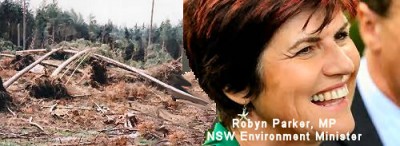 Embattled: Ms Parker – thinks she’s only accountable to herself and Premier O’Farrell.
Picture: Kristi Miller Source: The Daily Telegraph Embattled: Ms Parker – thinks she’s only accountable to herself and Premier O’Farrell.
Picture: Kristi Miller Source: The Daily Telegraph
.
.
New South Wales allowed logging in Koala Habitat
.
[Source: ‘NSW allowed logging on koala habitat’, by Rosslyn Beeby, Science and Environment Reporter, Canberra Times, 20110210, ^http://www.canberratimes.com.au/news/national/national/general/nsw-allowed-logging-on-koala-habitat/2072043.aspx]
.
<<The NSW Government has allowed 2,000 heactares of koala habitat to be logged at Coffs Harbour in northern NSW, despite a local koala conservation plan endorsed by the local council, a Senate inquiry has heard.
One of Australia’s leading koala researchers, Alistair Melzer, has accused federal environment bureaucrats of doing little to avoid ”an escalating conservation crisis” as koala populations decline.
Dr Melzer, who heads Central Queensland University’s koala research centre, told the Senate environment committee inquiry it appeared that Canberra’s bureaucrats ”do not seem to be sensitive to the real state of the environment”.
The six-month inquiry, into the conservation status and sustainability of Australia’s koalas, is investigating threats to the future survival of the species.
In his submission, former Coffs Harbour City Council deputy mayor Rod McKelvey said the NSW Department of Environment’s private native forestry division granted logging permits which resulted in the loss of 2000ha of ”core koala habitat” protected by the council’s koala conservation plan. Mr McKelvey said the department subsequently argued the plan ”did not fall under” NSW environmental planning policy.
”I do not want to be included in the generation who stood by and did nothing while we systematically destroyed koala habitat, making it almost impossible for them to live here,” he said.
Gunnedah farmer Susan Lyle, who has koalas on her three properties, raised concerns about a mining exploration licence issued for open-cut coal mining in the region.
”Our koalas will be decimated. This mining licence is primarily in isolation and to allow such a development is sheer lunacy … There are many, many other resources that can be used for energy, but there is no replacement for the koala,” she said.
.
.
Federal Forest Enquiry a Sham
.
[Source: ‘Federal Forest Inquiry a Sham’, 20111130, North East Forest Alliance, ^http://nefa.org.au/]
.
<<Conservation Group, North East Forest Alliance (NEFA), is outraged at the bias of the Federal House of Representatives report ‘Inquiry into the future of the Australian Forestry Industry’ and its refusal to consider the timber supply crisis and the over-logging of north-east NSW’s public forests.
NEFA spokesperson, Dailan Pugh, said that most of the evidence presented in NEFA’s 111 page submission was ignored by the inquiry on the grounds that it “criticised the industry”. “What they didn’t ignore they misrepresented. This pretend inquiry was a sham” he said.
“The Commonwealth is party to the North East Regional Forest Agreement (RFA) and claims that it satisfies its national and international obligations for the protection of world heritage, national estate and threatened species.
“While national heritage values were meant to be addressed as part of the RFA, they were not, so the Commonwealth gave the NSW Government an extra two years to complete the process. A decade later and there has still been no assessment and the Federal Government does not care.
“Similarly the RFA was meant to provide protection for nationally threatened species. The evidence we presented, such as the illegal trashing of a population of the nationally endangered fern Lindsaea incisa at Doubleduke, that was meant to be protected by a 50m buffer, was ignored because we were being ‘critical’.
“What is most astounding is that the inquiry refused to consider the evidence we presented on the current timber supply crisis due to the over-commitment of wood from north-east NSW’s public forests.
“Ever since new Wood Supply Agreements for timber from public land were given to sawmillers in 2004 Forests NSW have not been able to supply the committed volumes,” Mr Pugh said.
“The NSW Government’s recklessness in issuing these new Wood Supply Agreements has already cost taxpayers millions of dollars to buy back committed volumes and to compensate BORAL for Forests NSW’s failure to supply. As the crisis worsens, taxpayers exposure to multi-million dollar compensation claims grows.
“In vain efforts to meet shortfalls and reduce their payouts Forests NSW have been over-logging plantations, cutting trees before they mature, increasing logging intensities, logging stream buffers, and logging trees and areas required to be retained for threatened species. They are cutting out the future of the industry and causing immense environmental harm in the process.
“It is appalling, that an inquiry dealing with forestry has completely ignored this crisis and recommended that the Commonwealth Government condone and support this grossly unsustainable and irresponsible logging.
“Local Page MP, Janelle Saffin features in the inquiry’s report despite her electorate being one of the worst affected by the timber supply crisis, rampant illegal logging and widespread forest dieback.
“We call upon Janelle to please explain why the Commonwealth continues to ignore the gross over-logging, fails to identify and protect national heritage values, refuses to take action on the illegal logging of the habitat of nationally threatened species and refuses to consider the dieback of tens of thousands of hectares of public forests in her electorate. She needs to tell her constituents what she is going to do about it”” Mr. Pugh said.>>
.
.
South East Forest Rescue cranking it in south-east NSW
.
[Source: ‘South East Forest Rescue cranking it in south-east NSW’, 20120118, ^http://www.thelaststand.org.au/tag/southeast-forest-rescue/]
.
<<South East Forest Rescue have taken some crackerjack action this morning, halting forestry operations with a giant tripod and tree sit structure to highlight illegal logging in the Yambulla State Forest, south of Eden. The logging compartment where breaches have been identified by SEFR contains records of nationally listed endangered species such as glossy black cockatoos, smokey mice, southern brown bandicoots, tiger quolls, eastern pygmy possums, bent wing bats, yellow-bellied gliders, gang gang cockatoos and white-footed dunnarts.
“The response from Forests NSW shows the complete lack of regard for the licence conditions that Forests NSW and their contractors must abide by. The licence conditions for threatened species and habitat conservation are not being adhered to, even though the conditions are grossly inadequate” said forest campaigner Lisa Stone.
“We have reported the breaches in this compartment to the Office of Environment and Heritage,” said Ms Stone. “We stated last time that the probability of further breaches in this compartment if harvesting continues is high given that this logging contractor is a repeat offender and that FNSW still is not complying with the licence conditions” said Ms Stone.>>
.
.
‘NSW failing to protect koalas: Labor’
.
[Source: ‘NSW failing to protect koalas: Labor’, 20111027, AAP republished in the Sydney Morning Herald, ^http://www.smh.com.au/environment/conservation/nsw-failing-to-protect-koalas-labor-20111027-1mlnt.html]
.
<<The NSW Liberal government is failing to protect koalas by allowing logging in remaining habitats, the opposition says. Environment spokesman Luke Foley accused Environment Minister Robyn Parker of breaking an election promise to protect koalas after logging went ahead at the Bermagui State Forest on the south coast.
Logging also started last week at Boambee State Forest on the mid north coast, one of the last habitats for the vulnerable species in the area, Mr Foley said.
“For you to fail to respond and fail to intervene is a gross breach of your election policy to protect our national icon,” Mr Foley said at a budget estimates hearing in Sydney today. “Surely the precautionary approach would be for you as Environment Minister to stop the logging of this key koala habitat?”
Ms Parker denied breaking any election commitments, and said the government was working hard to protect koalas.
“When it comes to forestry, we are about getting a balance and protecting our native species. We are working very hard on them,” she said. “We have written to Forests NSW recommending a precautionary approach to managing impacts on koalas in the Boambee State Forest…The agreement that allowed logging to take place had been signed by the previous government, Ms Parker said. “Perhaps you should go back and look at what was going on when your government signed up to that agreement.”>>
.
.
Koala habitat cleared to make way for more houses
.
[Source: ‘Koala habitat cleared to make way for more houses’, 20121127 (today), by Nicole Fuge, Sunshine Coast Daily, ^http://www.sunshinecoastdaily.com.au/news/koalas-lose-vital-coast-habitat/1637085/]
.
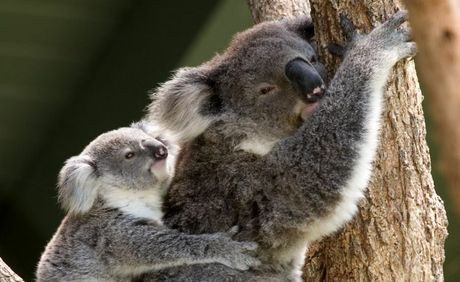
<<More than 100 hectares of koala habitat has been cleared to make way for more houses, another nail in the coffin for one of Australia’s icons.
Work has begun clearing the land behind Aussie World and the Ettamogah Pub for a 334-lot rural residential development.
Despite more than 30% of the 145-hectare site secured for environmental reserve and 12 hectares of revegetation to offset present clearing, Sunshine Coast Koala Wildlife Rescue volunteer Ray Chambers fears it’s not enough.
Mr Chambers said the area’s koala population was already fragile and the removal of so many trees would have a disastrous affect.
“We do have the odd koala in part of the Palmview area, it’s not a great deal but we know they are there,” he said. “From Forest Glen to the Caloundra turn-off is a koala corridor.”
.
Mr Chambers said there were only about 100 koalas left on the Coast, representing 18% of the Queensland population.
.
A council spokeswoman said despite approval of the development pre-dating an introduction of state-wide regulatory provisions for koala conservation, the council and Department of Environment and Heritage Protection officers had enforced koala protection measures and vegetation offsets.
Developer guidelines include:
- More than 30% of the original site secured in environmental reserve.
- Traffic calming, speed bumps, and fauna under and overpasses installed to minimise car strikes.
- Building envelopes to be enclosed with dog-proof fencing, leaving the balance of each lot free for fauna movement.
- About 12ha of revegetation, including planting koala food trees, to be carried out to offset the clearing.
The spokeswoman said a fauna spotting catcher had also been present during clearing.>>
..
Ed: What chance do Koalas have?
.
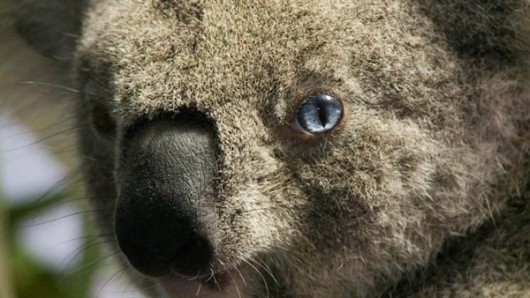 [Source: National Geographic, ^http://natgeotv.com.au/tv/koala-hospital/gallery.aspx] [Source: National Geographic, ^http://natgeotv.com.au/tv/koala-hospital/gallery.aspx]
.
Tags: Australia, Forests NSW, Government Loggers, Koala, koala extinction, koala habitat, New South Wales, NSW Forest Agreements, South East Forest Rescue
Posted in Gippsland (AU), Koalas, South East Corner (AU), Threats from Deforestation | 2 Comments »
Add this post to Del.icio.us - Digg
Friday, November 2nd, 2012
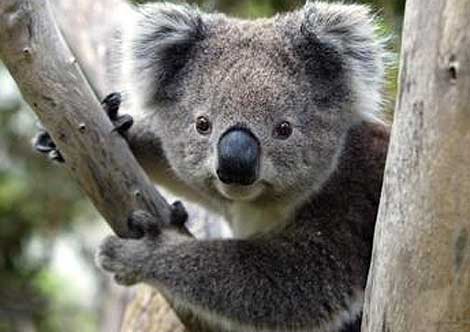 Once were common – now pose for the commoner! Once were common – now pose for the commoner!
Australia’s Koala
(Phascolarctos cinereus)
.
Australia’s iconic and once prolific Koala is now nationally listed as vulnerable to extinction.
What a despicable indictment of Australians!
<<The Koala was formerly common throughout the broad band of forests and woodlands dominated by Eucalyptus spp. extending from north Queensland to the south-eastern corner of mainland South Australia, Australia (Maxwell et al. 1996). However, the overall distribution of Koalas has been reduced since European settlement. This decline was primarily due to disease, bushfires, and widespread habitat destruction in the early decades of the 20th century.
Commercial poaching of koalas (they called it ‘harvesting‘) took place across the range towards the end of the 19th century and early 20th century (huge numbers, running into the millions, were killed for their pelts for a large export industry in Victoria, New South Wales, and Queensland). Koalas were widely hunted during the 1920s and 1930s, and their populations plunged.>>
Backward Queensland was the worst offender. In August 1927, the Koala fur trade saw the Queensland Government declare ‘open season’ on Koalas. Some 600, 000 koalas were shot to make gloves and hats in jut one month. It became known as ‘Black August‘.
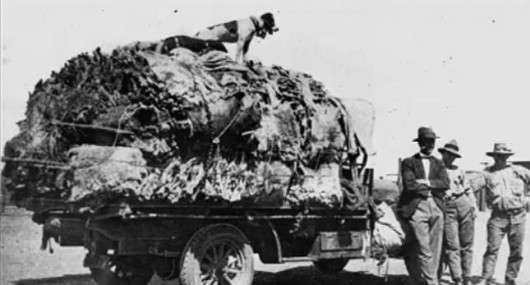 1927 ‘Black August’
When 600,000 Koalas were shot and skinned across Queensland
1927 ‘Black August’
When 600,000 Koalas were shot and skinned across Queensland
.
Commercial hunting was banned in Victoria in the 1890s, yet it continued sporadically (and under regulation) in backward Queensland until 1927 (Hrdina and Gordon 2004).

<<The Koala currently ranges from northeastern, central, and southeastern Queensland with patchy populations in western areas, to eastern New South Wales including the coastal strip and highlands of the Great Dividing Range, the western plains and related riparian environments where suitable habitat occurs, Victoria, and southeastern South Australia. The geographic range has contracted significantly due to loss of large areas of habitat since European settlement. In Queensland, extent of occurrence and area of occupancy have contracted by about 30% (Gordon et al. 2006).
Helped by reintroduction, Koalas have reappeared over much of their former range, but their populations are smaller and scattered. Koalas need a lot of space—about a hundred trees per animal—a pressing problem as Australia’s woodlands continue to shrink.>>
[Sources: The IUCN Red List of Threatened Species – Phascolarctos cinereus (Koala), ^http://www.iucnredlist.org/details/16892/0 ; ‘Koala’, National Geographic, ^http://animals.nationalgeographic.com/animals/mammals/koala/]
.
(2.6MB, pdf – NB. if slow to open, GoTo: File > Save As.., then open the PDF file from your auto-download folder)
.
[Source: The Decline in the distribution of the Koala in Queensland, G. Gordon, F. Hrdina, R. Patterson, Zoologist Vol 33, 2004,^http://www.rzsnsw.org.au/]
.
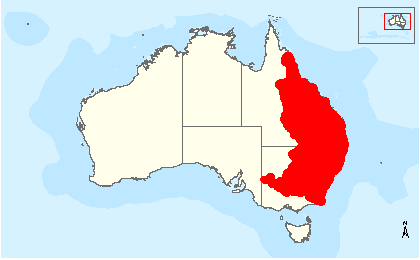 Koala Traditional Natural Range map (excluding Victorian and South Australia) Koala Traditional Natural Range map (excluding Victorian and South Australia)
[Source: ‘Koala (combined populations of Queensland, New South Wales and the Australian Capital Territory), Australian Government,
^http://www.environment.gov.au/cgi-bin/sprat/public/publicspecies.pl?taxon_id=85104]
.
<<Since European settlement, approximately 80% of Australia’s eucalypt forests have been decimated. Of the remaining 20% almost none is protected and most occurs on privately-owned land.>>
[Australian Koala Foundation, ^https://www.savethekoala.com/our-work/land-clearing-koalas]
.
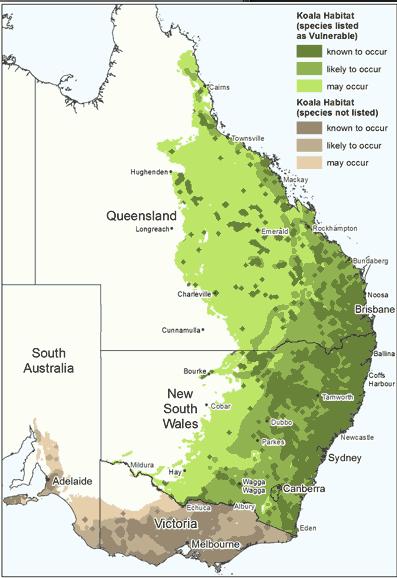 Koala reduced range map Koala reduced range map
Ed: Interpretation is Dark Green = known to occur, Light and Mid Green = used to occur
Dark green is where human population growth is worst!
(Source: ‘Koala (Phascolarctos cinereus) Listing’, Australian Government, 2012),
^http://www.environment.gov.au/biodiversity/threatened/species/koala.html]
.
.
Koalas partially listed as ‘Vulnerable’ to extinction
.
In April 2012, Australia’s Environment Minister, Tony Burke, declared that ‘at-risk’ koala populations along Australia’s eastern seaboard ‘vulnerable‘ under Australian national environment law – specifically under the Environment Protection and Biodiversity Conservation Act 1999.
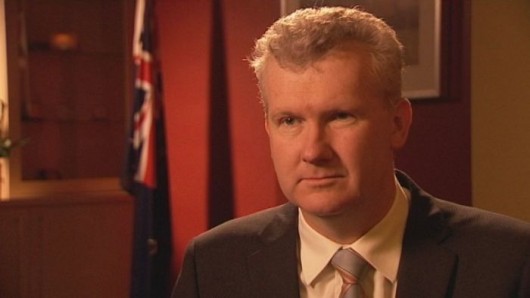 Australia’s Environment Minister, Tony Burke
Being interviewed on ABC Four Corners 20120821
[Source: ‘Koala Crunch Time’, ABC Four Corners, 20120821,^http://www.abc.net.au/4corners/stories/2012/08/16/3569231.htm] Australia’s Environment Minister, Tony Burke
Being interviewed on ABC Four Corners 20120821
[Source: ‘Koala Crunch Time’, ABC Four Corners, 20120821,^http://www.abc.net.au/4corners/stories/2012/08/16/3569231.htm]
.
This ‘EPBC Act‘ remains the Australian Government’s central piece of environmental legislation, providing a legal framework to protect and manage nationally and internationally important flora, fauna, ecological communities and heritage places. The Australian Government’s Department of Environment (etc) is currently developing EPBC Act referral guidelines for the Koala.
[Source: Australian Government, ^http://www.environment.gov.au/epbc/publications/interim-koala-referral-advice.html]
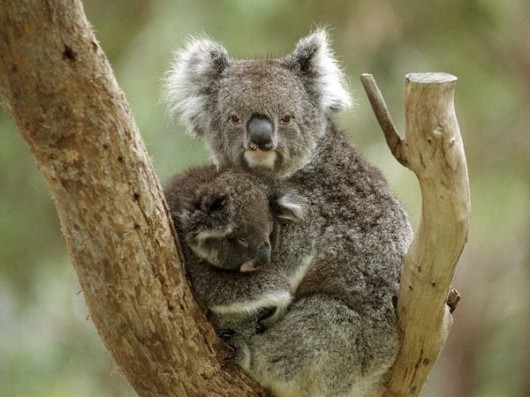 Koala with joey – zoo captive to benefit tourist visitation Koala with joey – zoo captive to benefit tourist visitation
[Source: Photo by Medford Taylor, National Geographic,
^http://animals.nationalgeographic.com/animals/mammals/koala/]
.
<<Rigorous scientific assessment by a variety of experts over the past three years has been reported back to Australia’s lead body on biodiversity conservation, the Threatened Species Scientific Committee (TSSC), which has found that Koala populations particularly in Queensland, New South Wales and Australian Capital Territory have declined markedly in recent years to a point where in these areas populations are vulnerable to regional extinction.
In 2011, the Threatened Species Scientific Committee combined available data for Koala populations across their natural range and generated estimates of the decline experienced over the period 1990–2010 by the national Koala population and, separately, the combined Queensland, NSW and ACT population (TSSC 2011bi).
The parameters of greatest uncertainty are the size of the Queensland population in 1990 and rate of subsequent decline, particularly in inland bioregions, and the size of the Victorian population.>>
The following table is a summary of the TSSC assessment of national Koala populations (TSSC 2012p):
| Region |
Date |
Best estimate |
Decline |
| Queensland |
1990 |
295 000 |
|
| 2010 |
167 000 |
43% |
| New South Wales |
1990 |
31 400 |
|
| 2010 |
21 000 |
33% |
| Victoria |
1990 |
215 000 |
|
| 2010 |
200 000 |
7% |
| South Australia |
1990 |
32 000 |
|
| 2010 |
19 500 |
39% |
TSSC 2012 Assessment of National Koala Populations
[Source: Koala (combined populations of Queensland, New South Wales and the Australian Capital Territory), Species Profile and Threats Database, Australia Government, ^http://www.environment.gov.au/cgi-bin/sprat/public/publicspecies.pl?taxon_id=85104]
.
<<These are the same regions where rapid ongoing housing development is allowed and encouraged, as Australia’s human population expands uncontrollably.
Mr Burke said “Koala populations are under serious threat from habitat loss and urban expansion, as well as vehicle strikes, dog attacks, and disease…In fact, in some areas in Victoria and South Australia, koalas are eating themselves out of suitable foraging habitat and their numbers need to be managed.”
“That is why the Scientific Committee recommended to me to list the Queensland, New South Wales and Australian Capital Territory populations as threatened, rather than to list the koala as nationally threatened across its full range.”
Mr Burke said the Gillard Government had committed $300,000 of new funding under the National Environmental Research Program Emerging Priorities to find out more about koala habitat.
“This funding will be used to develop new survey methods that will improve our knowledge of the quality of koala habitat using remote sensing, and help fill important data gaps to enhance our understanding and ability to protect the species,” Mr Burke said.
“The new funding is in addition to more than $3 million we have invested since 2007 to ensure the resilience and sustainability of our koala population.”>>
[Source: ‘Koala protected under national environment law’, The Hon Tony Burke MP media release, Minister for Environment etc, 20120430, ^http://www.environment.gov.au/minister/burke/2012/mr20120430.html]
.
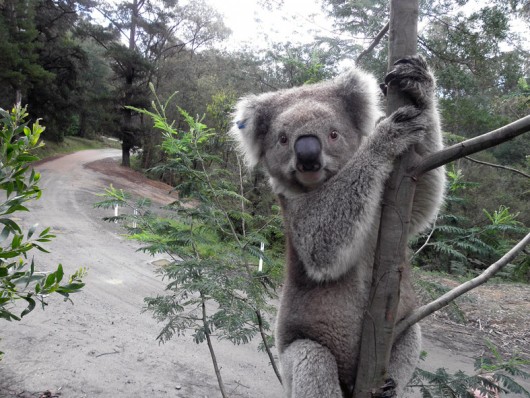 Koalas reduced to patchy populations
Below the IUCN radar/crisis, Koala functional extinction looms
… patchy populations, and more patchy every year.
Do we wait until Koala numbers downgrade to ‘Critically Endangered‘ before the Australian Government gives a toss! Koalas reduced to patchy populations
Below the IUCN radar/crisis, Koala functional extinction looms
… patchy populations, and more patchy every year.
Do we wait until Koala numbers downgrade to ‘Critically Endangered‘ before the Australian Government gives a toss!
[Source: ^http://home.vicnet.net.au/~fofkk/]
.
.
Australian Government – too little, too late, too selective
.
<<But the Australian Government’s announcement (back in April 2012, now six months ago) only confirmed what the Lismore-based ‘Friends of the Koala‘ group has known for more than a decade. Friends of the Koala volunteer carer Lola Whitney said the listing was long overdue.
“The work that we do here tells us that koalas are in danger of becoming extinct,” she said. “So many koalas come through our care centre every year, that it’s amazing we’ve got any around here at all. And the amount we lose from being hurt or from diseases – we lose a lot.”>>
.
Ed: But the Australian Government has only partially listed Koalas as vulnerable to extinction in Queensland, New South Wales and the Australian Capital Territory (ACT). Whereas Victorian and South Australian koalas were omitted.
.
This was because these were the recommendations of the 2011 Senate Enquiry, despite the TSSC confirmed 39% decline in the South Australian Koala population between 1990 and 2010.
.
Tony Burke as ultimate custodian: Why were problematic declining Koalas across South Australia and Victoria excluded from the EPBC Act?
.
It was also because the lead authority, the Threatened Species Scientific Committee, had “information gaps”, and because “the body of data on the status of koala populations is patchy, often sparse and not nationally comprehensive or coordinated”, the TSSC ignored the ‘Precautionary Principle and repeatedly rejected the Koala’s threatened species listing on the EPBC Act.
.
What it failed to appreciate was the more appropriate IUCN Red List categories of ‘DATA DEFICIENT’ (DD) and ‘NOT EVALUATED’ (NE).
.
.
The Conclusion by the 2011 Senate Committee Enquiry was selective. It read as follows:
.
<<The most prominent issue raised during this inquiry was whether the koala should be listed as a threatened species. Although the committee does not have the technical expertise of the TSSC, and therefore believes it is not qualified to determine whether or not the koala should be listed as threatened, the committee is deeply concerned about the sustainability of Australia’s koala population.
On one hand, the committee is pleased that the koala may not yet be eligible for listing as threatened. The committee believes that to have such a significant Australian icon
included on the threatened species list would be a national shame.
On the other hand, the committee believes there are parts of the koala population that require much greater protection. This is occurring to some extent in Queensland and NSW where the koala is listed in some areas under state environment protection legislation. However, state listing has not stemmed the marked decline in the population. If declines continue it will only be a matter of time before the koala is nationally listed as a threatened species.
The EPBC threatened species listing process is reactive and not well suited to the conservation needs of the koala. In the committee’s view, there ought to be processes available to enable proactive protection for the koala as well as other significant Australian species. In this regard the committee notes the possible mechanisms announced as part of the government’s response to the review of the EPBC Act which could enable a more proactive approach to koala conservation. Perhaps, building on the TSSC’s proposal to monitor species of cultural, evolutionary and/or economic significance, there ought to be a category of nationally significant species.
Ultimately, the committee would like to see Australia’s koala population return to plentiful numbers of healthy individuals, in resilient habitats, across the koala’s natural range.>>
[Conclusion, p. xix]
.
Threatened Species Scientific Committee repeatedly rejected Koala listing on EPBC Act
.
Three separate Listing Advices by the ‘ by the Threatened Species Scientific Committee (TSSC) to successive Australian Environment Ministers rejected the listing of the Koala as a threatened species on the EPBC Act, as follows:.
.
Feb 2006:
.
Due to the TSSC acknowledging that “there are still information gaps regarding the species’ conservation status“, the TSSC recommendation to Australia’s Environment Minister on Koala conservation was:
“The Committee recommends that the species Phascolarctos cinereus (Koala) is not eligible for inclusion in the list referred to in section 178 (Listing of Threatened Species) of the EPBC Act.”
[Source: ‘Advice to the Minister for the Environment and Heritage from the Threatened Species Scientific Committee (the Committee) on Amendments to the list of Threatened Species
under the EPBC Act’, 20060206, Item 6, p.15, Threatened Species Scientific Committee,^http://www.environment.gov.au/biodiversity/threatened/species/pubs/koala.pdf, >Read 2006 Listing Advice]
.
Sep 2010:
.
<<The body of data on the status of koala populations is patchy, often sparse and not nationally comprehensive or coordinated. The data quality is also variable. There has been only limited improvement in quality, relevance and integration of these data over the 15 years that the koala has been considered by this Committee and its predecessor. This situation is not unusual for the Committee but what is unusual is the huge area of occurrence and variability that the koala demonstrates. I addition there is a lack of any consistent reliable methodology for population monitoring of the koala.>>
.
<<In its deliberations, the Committee concluded that a Conservation Dependent listing for the koala could not be justified at this time.>>
.
[Source: Letter to Minster for Environment, by Associate Professor Robert J.S. Beeton, Chair, Threatened Species Scientific Committee, 20100930 ^http://www.environment.gov.au/biodiversity/threatened/species/pubs/koala-tssc-letter.pdf, >Read Sep 2010 Letter]
.
Feb 2011:
.
<<The Committee recommends that the list referred to in section 178 of the EPBC Act not be amended at this time by including the Phascolarctos cinereus (koala) in the list in the Vulnerable category.>>
.
[Source: ‘Advice to the Minister for Environment Protection, Heritage and the Arts from the Threatened Species Scientific Committee (the Committee) on Amendment to the list of Threatened Species under EPBC Act’, 20110211, Item 12, p.29, Threatened Species Scientific Committee,^http://www.environment.gov.au/biodiversity/threatened/species/pubs/koala-listing-advice.pdf, >Read Feb 2011 Listing Advice ]
.
Nov 2011 (change of heart, but ignoring Victoria and South Australia):
.
<<12. Recommendations
(i) The Committee recommends that the Minister declare the combined koala (Phascolarctos cinereus) populations in Queensland, New South Wales and the Australian Capital Territory to be a species for the purposes of the EPBC Act under s517 of the Act.
(ii) The Committee recommends that the list referred to in section 178 of the EPBC Act not be amended by including the koala (Phascolarctos cinereus) over its national extent.
(iii) The Committee recommends that the list referred to in section 178 of the EPBC Act be amended by including in the list in the Vulnerable category the combined koala (Phascolarctos cinereus) populations in Queensland, New South Wales and the Australian Capital Territory.
(iv) The Committee recommends that there should be a recovery plan for this species.>>
.
[Source: ‘Advice to the Minister for Sustainability, Environment, Water, Population and Communities from the Threatened Species Scientific Committee (the Committee) on Amendment to the list of Threatened Species under the EPBC Act, 20111125, Item 12, p.34, Threatened Species Scientific Committee,^http://www.environment.gov.au/biodiversity/threatened/species/pubs/197-listing-advice.pdf, >Read Nov 2011 Listing Advice ]
.
The current members of the Threatened Species Scientific Committee are:
.
- Professor Helene Marsh (Chair)
- Dr Guy Fitzhardinge
- Dr Gordon Guymer
- Professor Peter Harrison
- Dr Rosemary Purdie
- Dr Keith Walker
- Professor John Woinarski
- Dr Andrea Taylor
- Dr William Humphreys
- Dr Michelle Heupel
.
[Source: ‘Threatened Species Scientific Committee Members, Department of Environment (etc, Australian Govermment, ^http://www.environment.gov.au/biodiversity/threatened/committee-members.html]
 Professor Helen Marsh
TSSC Chair since August 2011 Professor Helen Marsh
TSSC Chair since August 2011
.
To his credit, Tony Burke had asked the Threatened Species Scientific Committee (TSSC) for more precise boundaries detailing areas where koala populations are in trouble.
In February 2012, Australian Koala Foundation chief executive officer Deborah Tabart said that this Senate Committee Enquiry document was telling Mr Burke that he should act now and not wait another 10 weeks.
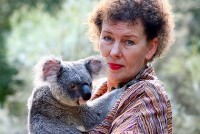 Deborah Tabart OAM
– not smiling Deborah Tabart OAM
– not smiling
.
<<“Minister Burke has delayed this decision, I think, twice and Minister (Peter) Garrett prior to that, I think, three times. “I’m just hoping that the Senate inquiry document, which is now firmly on his (Mr Burke’s) desk, should persuade him that, if nothing else, he should protect the koala under a precautionary approach”, said Tabart.>>
[Source: ‘Government ‘stalling’ on endangered koalas decision’, Feb 17, 2012, ^http://www.abc.net.au/news/2012-02-17/koala-listing-process-delayed/3835228 ]
.
[Source: Australian Parliament House, Senate Committees, >’The koala—saving our national icon’, 20110922, ^http://www.aph.gov.au/Parliamentary_Business/Committees/Senate_Committees?url=ec_ctte/koalas/report/index.htm]
.
<<The National Board of the Australian Koala Foundation (AKF), being much more aware of the Koala population range reality, undertook an extensive mapping project to quantify how many koalas remained in the wild, and where those koalas were located.
Extensive research was undertaken using National Vegetation Information System (NVIS) data, vegetation mapping, a bidling database of records for over 80,000 individually assessed trees from 2,000 field sites across the Koala’s range. Data has been collected by AKF from sixteen of the twenty-four Australian bioregions that the Koala is known to occur.>>
In 2011, the following map has been prepared estimating Australia’ national Koala population:
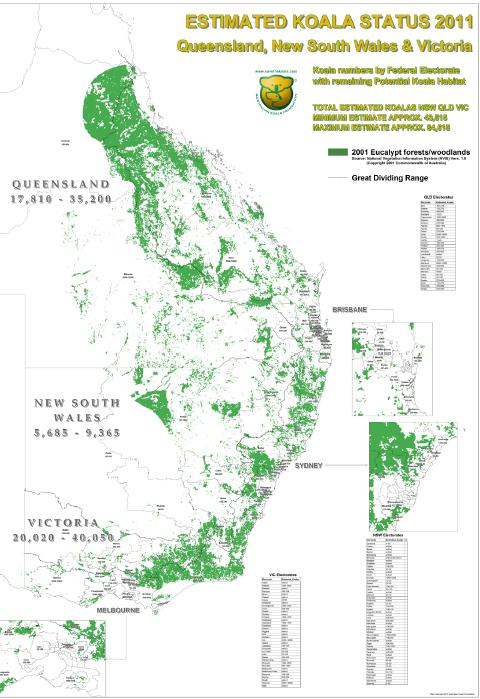 Estimated Australian Koala Population, 2011 Estimated Australian Koala Population, 2011
>Read Large Map(pdf) (3.4MB – – NB. if slow to open,
GoTo: File > Save As.., then open the PDF file from your auto-download folder)
[Source: ‘Bob’s Map’, Australian Koala Foundation,
^https://www.savethekoala.com/our-work/koala-numbers]
.
2011 Senate Committee: ‘The koala—saving our national icon’
.
The 19 Recommendations of the Senate Committee
.
<<Recommendation 1
The Australian Government fund research into the genetic diversity of the koala including a population viability assessment of the southern koala and determining priority areas for conservation nationally.
.
Recommendation 2
The Australian Government fund a properly designed, funded and implemented national koala monitoring and evaluation program across the full range of the koala.
.
Recommendation 3
The Australian Government establish a nationally coordinated and integrated program for population monitoring of threatened species and other culturally, evolutionary and/or economically significant species.
.
Recommendation 4
The Australian Government assist the koala research community and interested organisations to work towards a standardised set of methodologies for estimating koala populations.
.
Recommendation 5
The Threatened Species Scientific Committee provide clearer information to the Environment Minister in all future threatened species listing advices, including species population information, and that the Threatened Species Scientific Committee review its advice to the Minister on the listing of the koala in light of the findings of this inquiry.
.
Recommendation 6
The Australian Government undertake habitat mapping across the koala’s national range, including the identification of priority areas of koala conservation, with a view to listing important habitat under the provisions of the EPBC Act.
.
Recommendation 7
The habitat maps be used to identify and protect important habitat in known koala ranges.
.
Recommendation 8
The Australian Government review its land holdings which contain koala habitat and consider biodiversity, and specifically koala populations, in the management and sale of Commonwealth land.
.
Recommendation 9
The Australian Government actively consider options for recognition and funding for private land holders for the conservation of koala habitat.
.
Recommendation 10
The Australian Government fund research into koala disease, including the viability of vaccination programs and the effect of changes in leaf chemistry.
.
Recommendation 11
The Australian Government fund the Koala Research Network’s request for a Research Liaison Officer.
.
Recommendation 12
The Australia Government consider further wild dog control options in priority koala areas.
.
Recommendation 13
Local and state governments:
- Introduce appropriate speed limits in priority koala areas; and
- Where appropriate, build or retrofit underpasses or overpasses for major roads in priority koala areas as well as installing koala fencing adjacent to major roads.
.
Recommendation 14
Where the Australian Government provides funding for roads or other infrastructure in or adjacent to koala habitat, it be contingent on the provision of adequate koala protections.
.
Recommendation 15
The Australian Government work with the states to develop new national guidelines to ensure that all new roads and upgrades in or adjacent to koala habitat are koala-friendly.
.
Recommendation 16
The (Australian Government’s) Environment Minister consider the evidence provided to this inquiry when making his final decision on listing the koala as a threatened species.
.
Recommendation 17
The (Australian Government’s) Environment Minister consider options to improve the conservation status of the diverse and rapidly declining koala populations in New South Wales and Queensland to ensure a nationally resilient population is maintained. These options include listing the koala as vulnerable under the EPBC Act in areas where populations have declined significantly or are at risk of doing so.
.
Recommendation 18
An independent external review be conducted on the National Koala Conservation and Management Strategy to monitor the adequacy of progress. The review should assess and report on the progress made at the strategy’s midpoint.
.
The review must include an assessment of the:
- Strategy’s implementation to date and prospects into the future;
- Strategy’s effectiveness in stabilising koala numbers in areas of declining population, and in reducing the pressure of overabundant populations;
- Strategy’s level of ambition, including whether new elements are required; and
- Adequacy of the Commonwealth’s and the states’ respective roles and funding commitments.
.
Recommendation 19
The Australian Government adequately resource the National Koala Conservation and Management Strategy, and ensure that it is properly implemented through committing to a much stronger leadership role.>>
.
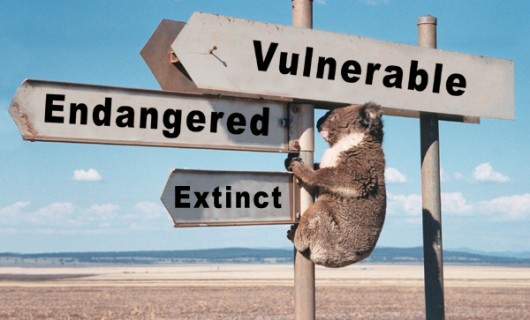 . .
.
Of note, ‘Recommendation 17‘ restricted the conservation status of the Koala only to ensure a ‘nationally resilient population is maintained’. That means that regional extinctions shall be acceptable, so long as a ‘nationally resilient population is maintained’ somewhere.
These are the places that the Koala is deemed to be declining and so given the vulnerable status. Other Koala populations elsewhere don’t weem to matter to the Australian Government.
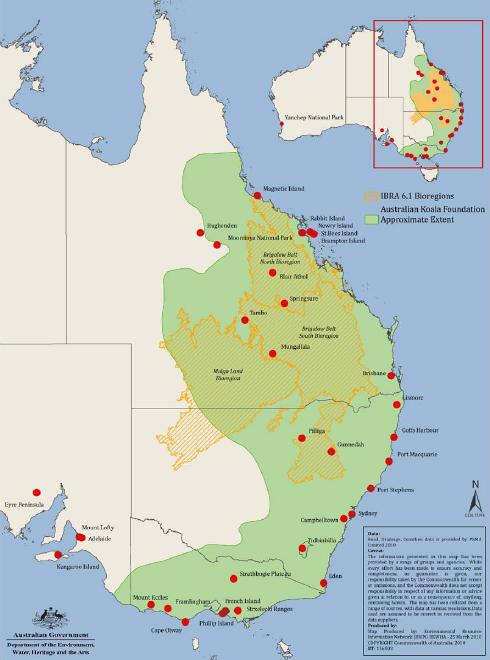 Koala tokenly listed as ‘Vulnerable’ but politically only at the above ‘selected places’
under the Environment Protection and Biodiversity Conservation Act (1999) Koala tokenly listed as ‘Vulnerable’ but politically only at the above ‘selected places’
under the Environment Protection and Biodiversity Conservation Act (1999)
.
.
2000: Even then, the United States recognised Koalas as ‘Vulnerable’
.
<<Back on 9th May 2000, the United States Government listed all koalas in Australia as vulnerable under the Endangered Species Act. The US Government determined that a) the eucalyptus and woodland ecosystems on which the arboreal marsupial depends has been greatly reduced, b) that despite conservation action by the governments of Australia, koala habitat continues to deteriorate, and c) that irrespective of koala numbers, the threats were present and real.
At the time, the Australian Government was outraged. The Australian Koala Foundation considered that the US may have been pointing out to Australia (when President Clinton and Vice President Al Gore were in power) that Australia needed to control its land clearing in readiness for the Kyoto Protocol on climate change. One petitioner pointed out that Australia at that time was clearing land second only to the Amazon.
At the time, the Victorian Government was pleading that they ‘had so many koalas they are pests’, and a similar cry was heard in the 2011 Senate Committee Enquiry into the plight of the Koala.
Australian Greens Leader, Senator Bob Brown had in 2010 successfully moved for a new Senate Comittee Enquiry to assess the threats to and management of koalas across the country. The Inquiry into the status, health and sustainability of Australia’s koala population, has particular reference to:
- the iconic status of the koala and the history of its management;
- estimates of koala populations and the adequacy of current counting methods;
- knowledge of koala habitat; d. threats to koala habitat such as logging, land clearing, poor management, attacks from feral and domestic animals, disease, roads and urban development;
- the listing of the koala under the Environment Protection and Biodiversity Conservation Act 1999;
- the adequacy of the National Koala Conservation and Management Strategy;
- appropriate future regulation for the protection of koala habitat;
- interaction of state and federal laws and regulations; and i. any other related matters.
.
Environment Minister Tony Burke appears to have been swayed by this plea as unlike his United States counterparts he did not consider the following in the American citation “…the actual number of koalas that were present at various times in the past and that may still exist is of much interest and helps to give some perspective but, as for many species, may not be the critical factor in determining whether the species is threatened. A low figure may reflect natural rarity of a population in marginal habitats. A high figure may be misleading if the entire habitat of the involved population faces imminent destruction”.
The document continues “…if we receive strong biological arguments, we would consider giving separate consideration to particular populations. It should be recognised, however, that koalas cannot be considered separate populations solely because they reside in different state jurisdictions”.
No such biological argument could be made. On the contrary, genetic studies in Victoria show that by and large all Victorian koalas, except those in the eastern part, are all pretty much genetically identical which means the future is bleak for conservation. Some of them even have testicles missing. On Kangaroo Island, some research suggests that as many as 29 per cent may have this affliction.
Imagine a koala that lives on the Murray River in New South Wales. On one side of the river, it has protection, but if it swims to Victoria, it does not. In AKF’s view, either the Australian Government values our national icon for its contribution to our nation or it does not.
As seen on Four Corners last night, the fur trade decimated the koala and the remnant populations are still low as a result of that slaughter.
Nowadays, the Koala pays its way in big tourism dollars, not the paltry one shilling (around 10 cents) per skin.
.
‘But the koala has powerful enemies. In the senate inquiry, developers, loggers, bureaucrats and even some departments of environment pleaded with the senators not to list the Koala because it would upset the developers or impede growth.’
.
The partial listing of the koala as vulnerable in NSW, ACT and Queensland can be seen as some sort of win, but will the existing legislation (the EPBC Act) be strong enough to protect the koala from long term destruction of its habitat?
Although the animal itself has been protected since 1936, its habitat really has not.
The Australian Koala Foundation believes its future lies in a koala-specific legislation similar to that of the American Bald Eagle Act, enacted in 1942. The Americans realised that if they did not do something strong and powerful they might lose their national icon forever. We believe that time has come now. The AKF estimates there may be as few a 43,000 koalas with no more than 85,000 left in its original habitat. If we are right, then there is no time to waste.
Greens Senator Bob Brown, as a final gesture before leaving Parliament, said he would support the AKF in our endeavours to enact a Koala Protection Bill. This should be a simple piece of legislation that basically says if you have koalas on your property that you cannot harm them, remove their trees and must – and that is the operative word – must ensure that your activity is benign for their long term future.
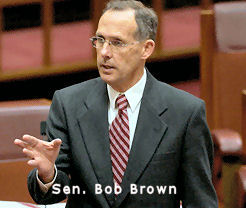
Four Corners has identified real threats to the koala and a partial listing will probably not make them go away. Neither will a specific piece of legislation, unless all our politicians actually realise we are at real risk of losing them.’>>
[Source: ‘Koalas deserve full protection‘, by Deborah Tabart, Chief Executive of the Australian Koala Foundation, 20120821, ABC, ^http://www.abc.net.au/environment/articles/2012/08/21/3571830.htm ; https://www.savethekoala.com/about-us/news-events/senate-inquiry]
.
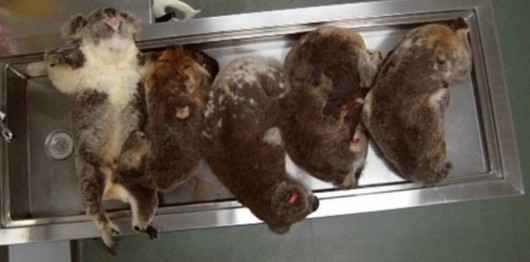 Dead Koalas on a vet’s autopsy table – with all the Green Talk how has it come to this?
Dead Koalas on a vet’s autopsy table – with all the Green Talk how has it come to this?
A native species that just sits up a tree, sleeps and hurts no-one
..now dying out because of Australian selfish viciousness.
Koalas are dying or being euthanised by the hundreds as a result of dog predation, road carnage, and Koala Habitat destruction.
[Source: ‘Koala Crunch Time’, ABC Four Corners (television programme), 20120821,
^http://www.abc.net.au/4corners/stories/2012/08/16/3569231.htm]
.
Watch ABC Four Corners Programme: ‘Koala Crunch Time‘
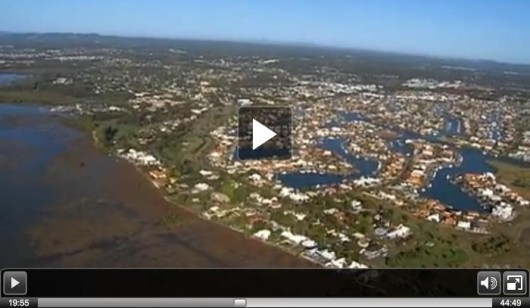 Australia’s Sprawl Profit overrules Biodiversity
‘Since 1997, koala hospitals along Australia’s eastern seaboard have recorded 15,000 Koala deaths’
[Source: Koala Crunch Time’, ABC Four Corners,^http://www.abc.net.au/4corners/stories/2012/08/16/3569231.htm] Australia’s Sprawl Profit overrules Biodiversity
‘Since 1997, koala hospitals along Australia’s eastern seaboard have recorded 15,000 Koala deaths’
[Source: Koala Crunch Time’, ABC Four Corners,^http://www.abc.net.au/4corners/stories/2012/08/16/3569231.htm]
.
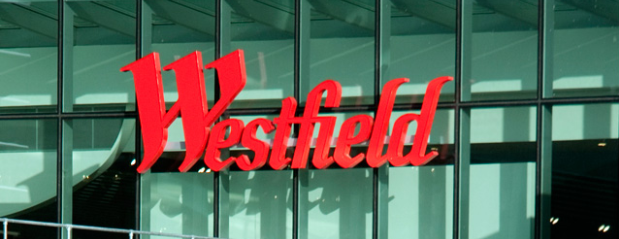 Westfield Shopping Centre development profiting out of Koala habitat apocalypse
Low (economic) Cost Housing, Coomera, Queensland Westfield Shopping Centre development profiting out of Koala habitat apocalypse
Low (economic) Cost Housing, Coomera, Queensland
.
.
IUCN wrongly continues to list Koalas as of ‘Least Concern’
.
Although Koala’s only exist naturally in Australia, at the international level the Koala (Phascolarctos cinereus) is still officially listed as of ‘Least Concern‘.
The most recent survey count of Koala status obtained by The International Union for Conservation of Nature (IUCN), the lead global authority on the environment and sustainable development, was back in 2008. Why, when the rapid decline data has been out since 2010?

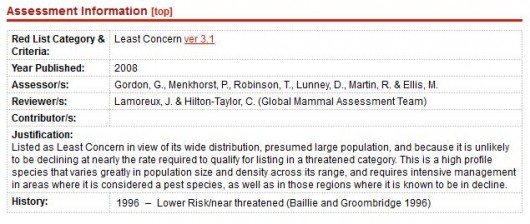 Phascolarctos cinereus (Koala)
The International Union for Conservation of Nature Red List of Threatened Species,
^http://www.iucnredlist.org/details/16892/0] Phascolarctos cinereus (Koala)
The International Union for Conservation of Nature Red List of Threatened Species,
^http://www.iucnredlist.org/details/16892/0]
.
The IUCN then assessed the Koala as having a ‘wide distribution’ and ‘a presumed large population’. It ignored regional declines and only regarded the national aggregate as appropriate data. Worse is that it stated thay the Koala “requires intensive management in areas where it is considered a pest species“.
Ed: What ecological incompetence, and wildlife hate would assess wildlife as a pest species?
.
The IUCN recognised that the Koala population was in decline in certain areas and identifed the following threats to the species:
- Continued habitat destruction, fragmentation, and modification (which makes them vulnerable to predation by dogs, vehicle strikes, and other factors)
- Bushfires
- Disease
- Drought associated mortality in habitat fragments
.
[Source: The IUCN Red List of Threatened Species – Phascolarctos cinereus (Koala), ^http://www.iucnredlist.org/details/16892/0]
.
Koala loss is symptomatic of Australia’s loss of much of the country’s native wildlife, its ecological communities and its biodiversity.
<<As of February 2011, a total of 1777 species are listed as threatened under the Environment Protection and Biodiversity Conservation Act (EPBC Act). A further 210 migratory and 464 marine species are also listed. The EPBC Act also lists 48 ecological communities as being threatened. These communities occur in a range of ecosystems including woodlands, forests, grasslands and wetlands.
Current threats to Australia’s biodiversity are:
- Habitat loss
- Degradation and fragmentation
- Invasive species and diseases
- Unsustainable use and management of natural resources
- Marine and coastal pollution (including from land based sources and vessels)
- Changes to the aquatic environment and water flows
- Changing fire regimes (Ed: bushfire management incompetence, and widespread Government-bush arson)
- Climate change.>>
.
[Source: ‘Status and Trends of Biodiversity’, Convention on Biological Diversity, ^http://www.cbd.int/countries/profile/?country=au#nbsap]
.
<<Friends of the Koala president Lorraine Vass said conservationists had been waiting for many years for koalas to be listed as vulnerable.
“At least a vulnerable to extinction listing,” she said. “It’s an additional layer of legislative protection and it’s better to have it than not to have it. “Apart from anything else it will be a very, very strong signal to everyone that at long last the nation is taking some responsibility for our national icon.”
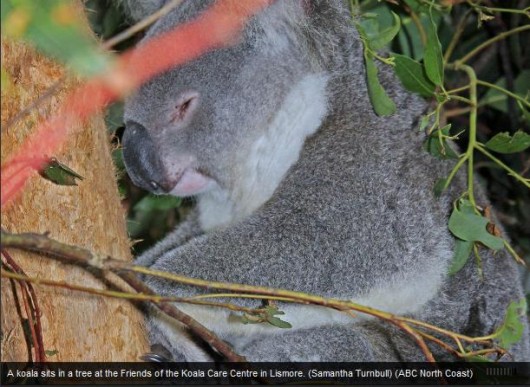
Ms Vass said statistics as well as anecdotal evidence showed koala numbers were rapidly declining, particularly in the Tweed (north eastern coastal New South Wales).
“I live at Wyrallah on a small property where koalas come and go, on the basis of observation at home I know that we’re seeing nowhere near as many koalas as we used to”, she said.
“In terms of statistics we’re actually bringing into care more koalas than we used to, but at the same time there are particular areas where we’re not bringing in as many koalas as we used to. So there are areas of local stress and the coastal area of Tweed is certainly one of those.”>>
[Source: ‘Greater protection for koalas‘, by journalist Samantha Turnbull, 20120430, ABC North Coast New South Wales, Australian Broadcasting Corporation, ^http://www.abc.net.au/local/photos/2012/04/30/3491805.htm, accessed 20121102]
.
<<This poor Koala was attacked by a Rottweiler in a suburban yard. It was reported that the koala was trying to get away and the dog grabbed it by the hindquarters as it was shimmying up a tree.
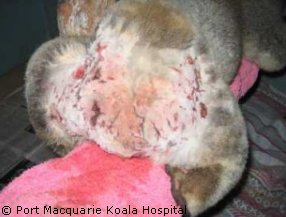 Koala injuries from a dog attack
Port Macquarie Koala Hospital
^http://www.koalahospital.org.au/ Koala injuries from a dog attack
Port Macquarie Koala Hospital
^http://www.koalahospital.org.au/
.
Sadly, this is a common occurrence with Koala’s. If it is not the hindquarters that are grabbed is around the neck or shoulder area. Usual injuries from this kind of incident are multiple puncture and tear wounds, with massive internal canine crush injuries. This koala had about 60 odd puncture wounds on his rump and groin area with many deep lacerations. His musculature around the groin and thigh area was lacerated pretty badly.
He died from shock, blood loss and ultimately a perforation of the intestine. The staff at the hospital gave him large amounts of fluids, and he was on strong painkillers and antibiotics. His wounds were flushed and he was kept in a warmed environment, but he died anyway.>>
[Source: Fourth Crossing Wildlife, ^http://www.fourthcrossingwildlife.com/dog_attack.htm]
.
.
Koala road deaths increasing
.
<<Not-for-profit conservation group, Friends of the Koala say 52 koalas were killed by vehicles on north coast roads last year.
The findings are part of the organisation’s annual report which documents the reasons behind the deaths of 222 north coast koalas. Association president Lorraine Vass says dog attacks and disease account for many koalas in their care. But she says hits from cars are the biggest concern.
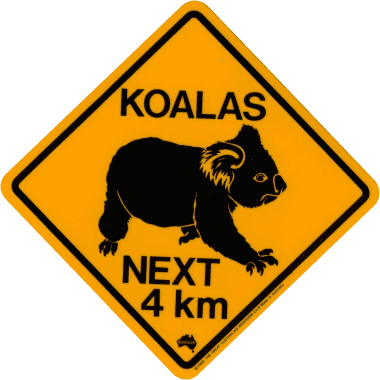
“One disturbing trend is an increase in road strikes,” she said. “Unfortunately that is a number that just keeps on increasing and last year we had 52 reports of koalas hit by cars. “Most of them, I’m afraid, were mortalities.”
But Ms Vass says there’s a positive outlook for koalas despite the figures. “I think there’s a lot to be optimistic about in terms of what’s going on with koala protection this year we’ve seen Lismore, we’ve got Tweed and Byron, those councils all working on a koala plan of management,” she said. “We’ve seen the federal announcement of the koala being listed under federal law as I say there’s a lot to be optimistic about.”>>
[Source: ‘Koala road deaths on rise‘, by Elloise Farrow-Smith, ABC, 20121019, ^http://www.abc.net.au/local/stories/2012/10/19/3614061.htm]
.
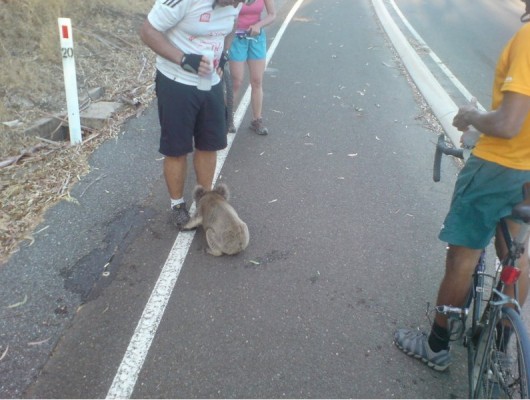 Koalas face a bleak future Koalas face a bleak future
.
Ed: The International Union for Conservation of Nature‘s global framework God-like governance for wildlife threatened by humanity is all about prioritising wildlife species most at risk of extinction for most protection.
.
It proclaims that if a species is not about to become extinct in the next ten years, its is not as important for conservation as those species that are.
.
But this is an Armageddon last man standing rationalisation. It may be administratively convenient, but it is an economic utilitarian philosophy that denies the rights of native wildlife to exist freely without persecution.
.
Were such an IUCN rationalist framwork applied to humans, such that don’t worry about say Chinese or Indians catching a deadly pandemic because there are a billion of them, it would be labelled as Herbert Spencer’s Social Darwinism or as Nazi Eugenics and quite rightly so. At The Habitat Advocate we espouse a worldview of Nature through: ^Deonteological Ethics and >Species Justice.
.
Every wildlife individual is valuable and has existence rights no different to humans.
.
Test: Would a human mother sacrifice her eldest or her youngest?
.
[Ed: All references sourced for this article 20111102]
.
.
Further Reading:
.
[1] ‘Koala Species Profile‘, Species Profile and Threats Database, Department of Environment etc, Australian Government, ^http://www.environment.gov.au/cgi-bin/sprat/public/publicspecies.pl?taxon_id=85104
.
[2] ‘Listing Advice to protect the Koala under the EPBC Act‘, Department of Environment etc, Australian Government,^http://www.environment.gov.au/biodiversity/threatened/species/pubs/197-listing-advice.pdf >Read Listing Advice (42 pages, PDF, 400kb – – NB. if slow to open, GoTo: File > Save As.., then open the PDF file from your auto-download folder)
.
[3] Koala Habitat Distribution Map (surveyed in 2011), Department of Environment etc, Australian Government, 2012 ^http://www.environment.gov.au/biodiversity/threatened/species/pubs/phascolarctos-cinereus-distribution-map.pdf
>Read Map (PDF, 300kb – NB. if slow to open, GoTo: File > Save As.., then open the PDF file from your auto-download folder)
.
[4] ‘Koala now threatened species‘, 20120215, Radio National Breakfast (radio programme), Australian Broadcasting Corporation,’There’s quiet optimism among koala experts that our national icon will finally be classified as a threatened or endangered species’.^http://www.abc.net.au/radionational/programs/breakfast/2012-02-15/3830832
>Play .mp3 audio:
 ℗ 2012 Australian Broadcasting Corporation ℗ 2012 Australian Broadcasting Corporation
.
[5] ‘Iconic animals – the koala‘, by Margot Foster, 20111228, ABC Rural (radio programme), Australian Broadcasting Corporation,
Abstract: ‘Michael Cathcart looks at the current efforts to protect this vulnerable animal. A senate committee has been looking into ‘the status, health and sustainability of Australia’s koala population’. He discovers the koala’s role as a cultural icon and the impact on our awareness of the koala, made by Norman Lindsay, as well as Dreamtime representations of the koala which reveal a great deal about the unique physiology and habits of this elusive animal.
The history of extensive slaughter of the koala since white settlement, because of the quality of its fur and value abroad, is an irony today because on Raymond Island, East Gippsland, koalas are making too many babies. There are about three hundred koalas on the small island and Department of Sustainability and Environment wildlife manager Charlie Franken says that’s about 250 too many.
Michael Cathcart speaks with Deborah Tabart OAM, CEO of the Australian Koala Foundation; Ann Moyal, author Of “Koala: A Historical Biography”; Michael J Connolly, Munda-gutta Kulliwari, Dreamtime Kullilla-Art; Helen Glad, Norman Lindsay’s grand daughter; Ann Moyal, author and historian; Charlie Franken, wildlife manager, Department of Sustainability and Environment; Dr Jay Patterson, Melbourne zoo vet and Dr Grant Kuseff, Bairnsdale veterinary surgeon;
^http://www.abc.net.au/rural/telegraph/content/2011/s3390776.htm
>Play .mp3 audio (large data file so may take a minute):
 ℗ 2011 Australian Broadcasting Corporation ℗ 2011 Australian Broadcasting Corporation
.
[6] ‘Interim koala referral advice for proponents‘, June 2012, Department of Environment (etc.), Australian Government,
Abstract: ‘Koala (Phascolarctos cinereus) populations in Queensland (QLD), New South Wales (NSW) and the Australian Capital Territory (ACT) have been listed as vulnerable under the Environment Protection and Biodiversity Conservation Act 1999 (EPBC Act). This listing came into legal effect on 2 May 2012. The listed threatened QLD, NSW and ACT populations are hereafter referred to in these guidelines as the koala.’
^http://www.environment.gov.au/epbc/publications/pubs/bio240-0612-interim-koala-referral-advice.pdf
.
[7] Australian Koala Foundation, ^ https://www.savethekoala.com/
 . .
[8] Koala Hospital, Port Macquarieuth Wales, ^ http://www.koalahospital.org.au/
 . .
[9] IUCN. (2001). IUCN Red List Categories and Criteria: Version 3.1. IUCN Species Survival Commission. IUCN, Gland, Switzerland and Cambridge, UK. ii + 30 pp, ^ http://www.iucnredlist.org/documents/redlist_cats_crit_en.pdf , >Read Document
.
Tags: Australian Koala Foundation, Black August, endangered koalas, Environment Protection and Biodiversity Conservation Act, Estimated Australian Koala Population, Friends of the Koala, Greater protection for koalas, iucn, Koala, Koala Crunch Time, koala extinction, koala habitat, Koala Protection Act, Koala Protection Bill, Koala road deaths, Koala road deaths on rise, National Koala Conservation and Management Strategy, New South Wales, Phascolarctos cinereus, Queensland, Save the Koala, Senate Committee Recommendations, South Australian koalas, The International Union for Conservation of Nature, The koala—saving our national icon, Threatened Species Scientific Committee, Victorian koalas, Westfield
Posted in Koalas, Threats from Development | 2 Comments »
Add this post to Del.icio.us - Digg
Sunday, September 2nd, 2012
[The following article was written by Tigerquoll and initially published under the title ‘Anthology of State Serial Rape of Bermagui’s Spotted Gum Forest Habitat‘, on ^CanDoBetter.net 20100216]
 Click this image to play music
then click back to this article as it plays Click this image to play music
then click back to this article as it plays
.
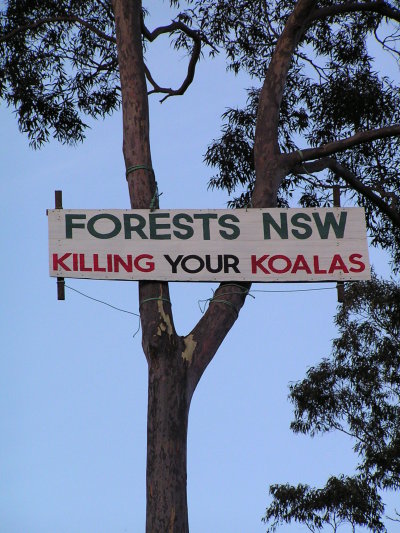 Nothing less than the Australian Government can be trusted to protect vital Koala Habitat.
Lesser smaller-minded state governments only see Koala Habitat as a logging and tourism resource.
Small minded politicians like Kristina Keneally can never be trusted with national treasures
Nothing less than the Australian Government can be trusted to protect vital Koala Habitat.
Lesser smaller-minded state governments only see Koala Habitat as a logging and tourism resource.
Small minded politicians like Kristina Keneally can never be trusted with national treasures
.
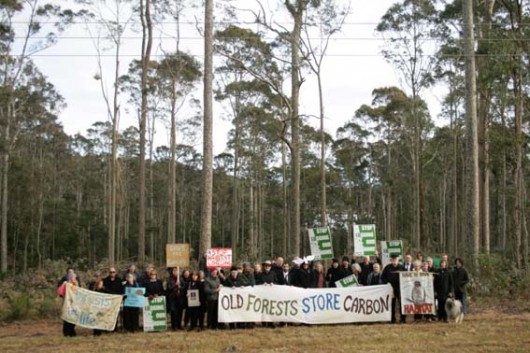 Bermagui’s Spotted Gums
..the local Narooma Community in their defence against ‘Forest NSW’ (the Forest-Fiddling loggers)
Bermagui’s Spotted Gums
..the local Narooma Community in their defence against ‘Forest NSW’ (the Forest-Fiddling loggers)
.
 Forest-Fiddling Logger driving his Spotted Gum spoils truck
Forest-Fiddling Logger driving his Spotted Gum spoils truck
.
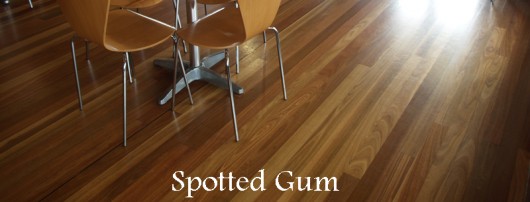 But Eucalyptus maculata is a tree, not a floor But Eucalyptus maculata is a tree, not a floor
.
In terms of Australia’s iconic ‘Spotted Gum’, the word “spotted” refers to the soft mottled colour caused by weathering of the outer tree as it sheds elliptical strips of bark.
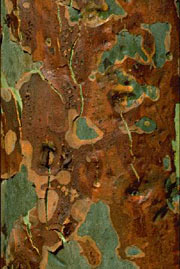 Spotted Gum bark Spotted Gum bark
.
This colour varies from pale greybrowns and soft creams to a rich chocolate brown. A very tough timber, its frequent wavy grain can produce an attractive and highly valued fiddleback effect. [Source: Boral website, ^http://www.boral.com.au/timberflooring/timber_species_-_spotted_gum.asp]
.
 Build something great, but don’t destroy something great in the process
– like Koala Spotted Gum Forests!
Invest in Boral and you invest in Koala extinction
Build something great, but don’t destroy something great in the process
– like Koala Spotted Gum Forests!
Invest in Boral and you invest in Koala extinction
.
About 380km south of Sydney lies what NSW Tourism labels the beautiful ‘Sapphire Coast’ with the popular seaside town of Bermagui.
Less than 3km north of Bermagui heading north along Bermagui-Cobargo Road and up the Bermagui River estuary is the Bermagui State Forest – a label by the NSW Department of Primary Industry (DPI) given to magnificent Spotted Gum forest.
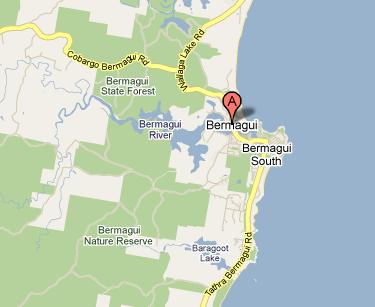 . .
This forest is vital habitat for threatened native fauna – the Yellow Bellied Gliders, Grey-Headed Flying Foxes, Tiger Quolls, Sooty Owls, Sea Eagles, Possums and Australia’s iconic Koala.
.
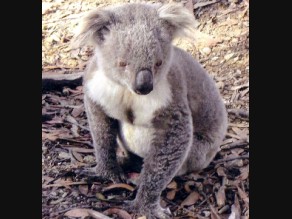 Koala in Bermagui’s Spotted Gum forest – a displaced landlord
Koala in Bermagui’s Spotted Gum forest – a displaced landlord
.
Australia’s iconic ‘Spotted Gums’
.
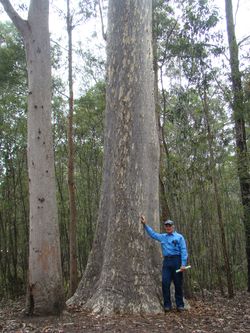 A mature iconic Spotted Gum Tree
About 400 years old, about 30 metres high
A mature iconic Spotted Gum Tree
About 400 years old, about 30 metres high
[Source: ‘A gum tree that saw Captain Cook and before’, ABC Radion interview of John Knight by Ian Campbell, 20100119,
Listen to Interview: ^http://blogs.abc.net.au/nsw/2010/01/a-gum-tree-that-saw-captain-cook-and-before.html]
.
Australia’s magnificent and unique Spotted Gums are naturally distributed in open forests along the hilly coastal corridor from south-east Queensland down through New South Wales and with a few isolated pockets in East Gippsland, Victoria. They belong to the botanical family ‘Myrtaceae’ and grow straight and tall up to 40 metres. Their height attracts roosting by Sea Eagles.
 Note the planet’s sole natural distribution of Spotted Gum Forests
They have become the target of corporate development simply because Spotted Gums prefer a mild temperate climate near the coast
..like Australia’s millions of breeding humans, and profiteering corporate developers
Note the planet’s sole natural distribution of Spotted Gum Forests
They have become the target of corporate development simply because Spotted Gums prefer a mild temperate climate near the coast
..like Australia’s millions of breeding humans, and profiteering corporate developers
.
Spotted gums flower once every two years and produce a rich pollen that attracts native birds such as Lorikeets and Yellow Tailed Cockatoos as wells as possums and flying foxes including the IUCN vulnerable listed Grey-Headed Flying Fox. [Source: Australian Native Plants Society, Corymbia maculata, ^http://asgap.org.au/c-mac.html]
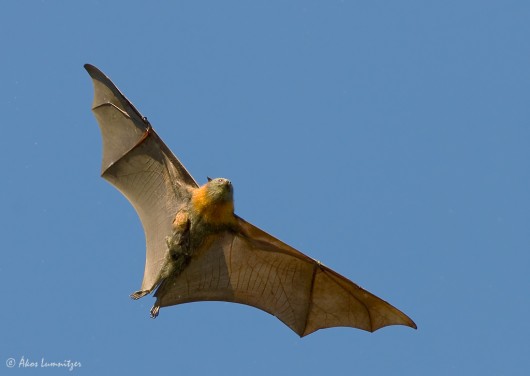 Grey-Headed Flying Fox (Pteropus poliocephalus)
The grey-headed flying-fox is listed as vulnerable to extinction under NSW and Australian legislation because of declining numbers and key threats such as habitat loss and urban conflict. Records indicate that grey-headed flying-foxes may once have numbered in the millions, but are now reduced to as few as 400,000. In the decade before listing, their population was estimated to have declined by 30%.
(Photo by Ákos Lumnitzer, ^http://amatteroflight.com/) Grey-Headed Flying Fox (Pteropus poliocephalus)
The grey-headed flying-fox is listed as vulnerable to extinction under NSW and Australian legislation because of declining numbers and key threats such as habitat loss and urban conflict. Records indicate that grey-headed flying-foxes may once have numbered in the millions, but are now reduced to as few as 400,000. In the decade before listing, their population was estimated to have declined by 30%.
(Photo by Ákos Lumnitzer, ^http://amatteroflight.com/)
.
Unlike the declaration of a ‘National Park’ which affords federal environmental protection to forest habitat, the State label of a ‘State Forest’ is a misnomer. A ‘State Forest’ is deemed a timber and woodchip resource for logging. The same public relations label is used across New South Wales, ACT, Victoria, Western Australia, Tasmania and Queensland. A State Forest is not treated as a forest for its natural habitat values, but rather as a logging coup on death row, that can be chainsawed at will anytime. Perhaps ‘Death Row Forest’ is a more apt label than speaking the State euphemism of ‘State Forests’.
And its public relations label logging as ‘harvesting’, a euphemism to belie the destructive reality.
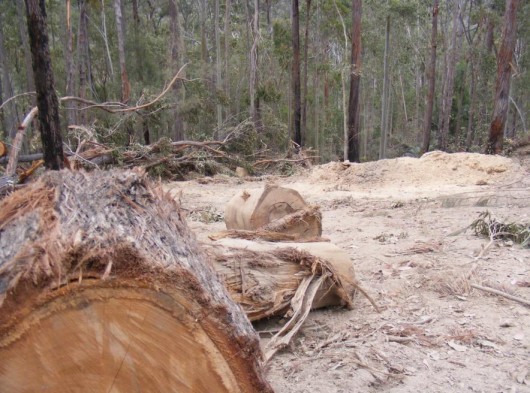 Bermagui State Forest after the loggers Bermagui State Forest after the loggers
.
The NSW Logging Offensive of 1988
.
On the back of a century of clear felling Bermagui State Forest was logged in the late 1980s. Then according to data from the ‘Bureau of Resource Science‘ (aka science graduates on the payroll of loggers), 148ha were “thinned” in 1996, and another 133ha that same year, then 94ha in 1999.
Typically 70% of the spotted gums goes to Boral’s mills in Narooma, Nowra and Batemans Bay as sawlogs to be processed into mainly flooring. The remainder end up as woodchips at Nippon Paper’s woodchip mill at Twofold Bay for export to Japan.
So Australia’s precious endangered habitat is being destroyed for house flooring and office paper. .
.
The NSW Logging Offensive of 2008
.
In October 2008, NSW Forests logged what it labeled “two compartments” in Bermagui State Forest north of Bermagui. It justified this under the infamous Eden Regional Forest Agreement (RFA). [>Read Agreement] [Source: ^http://www.daff.gov.au/__data/assets/pdf_file/0009/51021/nsw_rfa_eden.pdf]
This RFA is one of three established in 1999, in which the NSW Government relegated 15.1 million hectares of native forests across New South Wales for logging anytime. The usual public relations spin preceded the logging. Southern Region manager of Forests NSW, Ian Barnes.
It was at this time that Labor’s Minister for Primary Industries (Forests NSW) Ian MacDonald and Labor’s Minister for Police Tony Kelly started to use Dick Cheney tactics to push their weight around with protesters. The following questions to the NSW Legislative Council by NSW Greens Senator Lee Rhiannon on 28th October 2008, highlight the escalated use of law enforcement into a heavy handed riot squad:
.
Lee Rhiannon MLC:
“I direct my question to the Minister for Police. Did officers stationed at Batemans Bay police station in collaboration with Forests New South Wales hold a meeting at the Bermagui Country Club in September to warn locals associated with calling for forest protection not to protest when logging commenced in the Bermagui State Forest? Does the holding of this meeting reflect that Batemans Bay police officers have adopted a zero tolerance policing approach to forest protesters? Considering that since logging started in Bermagui State Forest on 27 October with a group of about 40 protesters gathered in the vicinity, about 15 police cars, more than 20 police, including members of the Public Order and Riot Squad, a mobile police command bus and two police rescue vans have been in attendance, will this level of policing continue for the coming six weeks of logging in this area? What is the anticipated cost of this operation?
.
Tony Kelly MLC (response):
“The Far South Coast Local Area Command of the New South Wales Police Force has been advised that New South Wales Forests is to commence logging compartments of Bermagui State Forest later this month. As in the past, protests are expected. As always, the New South Wales Police Force is committed to maintaining public order. For this reason, local police and various commands, including the Public Order and Riot Squad, Highway Patrol and Rescue Squad will join together to conduct an operation.
This operation will focus on ensuring the protection of persons engaged in lawful activities. Local police have made it clear that anyone engaging in unlawful or dangerous activity in or near the logging operation will have action taken against them. When offences continue and are considered dangerous, police will arrest and charge people as necessary. Police respect people’s rights to protest during these times; in no way are they looking to prevent lawful and peaceful protests. Police have asked anyone who intends to protest to contact them so that they can attempt to facilitate lawful activity, minimise disruption and focus on protecting the safety of everyone involved.”
.
[SOURCE: ‘Bermagui State Forest Logging Protests‘, Question raised NSW Legislative Council by The Greens Senator Lee Rhiannon, Parliament of New South Wales, Hansard, 20081028, ^http://www.parliament.nsw.gov.au/prod/parlment/hanstrans.nsf/V3ByKey/LC, 20081028, >Read Hansard Extract – go to page 10631, PDF, 344kb ]
.
The NSW Logging Offensive of Feb 2009
.
On Monday 2nd February 2009, logging operations resumed in the Bermagui State Forest after the summer holiday break period and continued for about two months.
Bruce Mathie and Sons is one of the prominent loggers in the area, but most timber finds its way either as saw logs to Boral for Spotted Gum flooring or else to Nippon Papers woodchip mill at Twofold Bay, Eden for export to Japan.
The forest eco-rapers ‘Forests NSW’ – bulldozed, chainsawed, logged, then left with their booty.
.
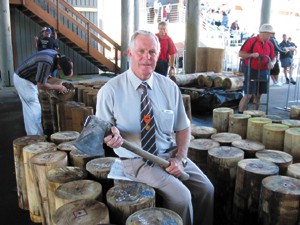 Kevin Mathie – 4th generation logger Kevin Mathie – 4th generation logger
.
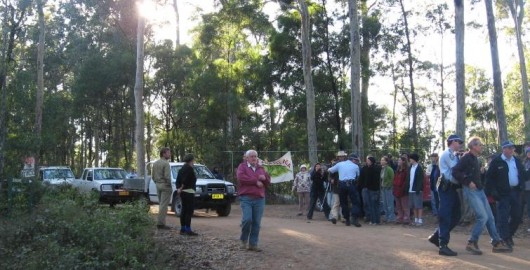 Logging contractor, Gil Mathie, in the middle of the picture at front (pink jumper)
More notably, this editor is saddened by bearing witness to a senior member
of the Bermagui community being arrested for conserving Spotted Gums and Koalas.
We love, we defend, we act for love.
Salute the man being arrested.
[Source: Local environmentalist, John Perkins, Gulaga Protest near Tilba on the NSW South Coast, 20070514]
Logging contractor, Gil Mathie, in the middle of the picture at front (pink jumper)
More notably, this editor is saddened by bearing witness to a senior member
of the Bermagui community being arrested for conserving Spotted Gums and Koalas.
We love, we defend, we act for love.
Salute the man being arrested.
[Source: Local environmentalist, John Perkins, Gulaga Protest near Tilba on the NSW South Coast, 20070514]
.
Labor’s Ian MacDonald’s Forestry Regulation of 2009
.
But rather that do the right thing by the Environment and by the Community and obey the law of the land, those in power The Labor Government’s (Forests NSW) forced changes to the law of the land to bloody well suit themselves. Arguably reminiscent of England’s King Henry VIII changing laws to accommodate his adultery, or Joh Bjelke-Petersen’s gerrymandering that secured his electoral hold on power.
In order to keep the cameras and local conservationist away from the loggers destructive practices, Forests NSW got the Minister to legislate an exclusion area around its logging with the public relations labeling of “mainly for safety reasons”.
On 1 September 2009, the NSW Forestry Regulation 2009 came into force making it illegal for anyone to trespass into areas marked by NSW Forests for logging. This has given Forests NSW absolute logging power with the police as its enforcement lackies.
Forests NSW Minister for Primary Industries, Ian MacDonald, tabled the Bill and it became law preventing democratic protests by people trying to save important habitat from destruction. It has given loggers free reign to log State Forests with impunity.
Under Part 3, Division 1, Clause 11 of this Regulation, a logger has legal authority to request anyone to leave a forestry area and this includes if that person “causes inconvenience.”
Under Clause 12, a logger can forcible remove anyone from a forestry area “who is causing annoyance or inconvenience.”
Surely such removal by a logger can be construed an assault under the Crimes Act? It is draconian. It is certainly an assault on Australians’ democratic right to protest. What was Ian MacDonald thinking?
.
Labor’s Ministers in charge three years hence…
.
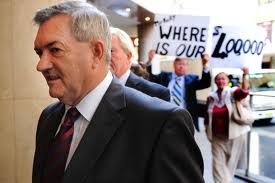 Labor’s Police Minister Tony Kelly MLC
NSW Minister for Emergency Services, Lands, Police and Primary Industries.
Labor’s Police Minister Tony Kelly MLC
NSW Minister for Emergency Services, Lands, Police and Primary Industries.
.
‘Tony Kelly was targeted by protesters as he arrived to give evidence at the ICAC in June. Today the commission has found the former minister engaged in corrupt conduct.’
[Source: Protesters target Kelly outside ICAC’, by Dean Lewins, AAP, 20111212, ^http://www.abc.net.au/news/2011-12-12/protesters-target-kelly-outside-icac/3725744]
.
‘DISGRACED former state Labor ministers Tony Kelly and Ian Macdonald are demanding taxpayers foot their legal bills and the state government could be forced to hand over up to $250,000. Despite being found by corruption watchdog ICAC to have forged official documents while a minister, Mr Kelly has formally asked the O’Farrell government to cover the cost of his elite legal team.’
[Source: ‘Disgraced former Labor ministers Tony Kelly and Ian Macdonald demand taxpayers foot their bills’, by Barclay Crawford, Daily Telegraph, 20120101, ^http://www.dailytelegraph.com.au/news/disgraced-former-labor-ministers-tony-kelly-and-ian-macdonald-demand-taxpayers-foot-their-bills/story-e6freuy9-1226234077573].
.
 Labor’s Logging Minister Ian MacDonald MLC
Forests NSW/ Minister for Primary Industries in 2009 Labor’s Logging Minister Ian MacDonald MLC
Forests NSW/ Minister for Primary Industries in 2009
.
‘The disgraced former NSW resources minister Ian Macdonald is to face a new corruption inquiry into the granting of coal exploration licences. The Independent Commission Against Corruption said in a statement yesterday that Mr Macdonald is being investigated for allegedly using his ministerial position ”to advantage the private interests of others”.
[Source: ‘ICAC to examine mining licences‘, by Kate McClymont, Senior Reporter, Sydney Morning Herald, 20120524, ^http://www.smh.com.au/nsw/icac-to-examine-mining-licences-20120523-1z5ov.html‘]
.
‘The senior state minister Ian Macdonald signed taxpayers up to the V8 Supercars race without a system to manage potential conflicts of interest, without advice from the government’s major events body and without a proper business case, the NSW Auditor-General finds.’
[Source: ‘Mate’s race: $45m deal snares MP‘, by Anne Davies, Linton Besser and Nick O’Malley, 20100529, ^http://www.smh.com.au/nsw/mates-race-45m-deal-snares-mp-20100528-wldb.html]
.
The NSW Logging Offensive of Sep 2009
.
In September 2009, Forests NSW commenced logging again in Bermagui State Forest, like pack rapists marauding through a maternity ward.
Sure enough, on Monday, 14th September 2009, Police arrested two of four forest campaigners who had allegedly entered Bermagui State Forest in what Forests NSW had labeled logging compartments 2001 and 2002. Apparenpe known to support koalas is unacceptable, particularly when the NSW government cannot prove their claims that koalas can be found anywhere in the south east,” said Robert Bertram, local Friends of Five Forests member.
“This is yet another example of Forests NSW lack of care for community and the environment,” said Lisa Stone, spokesperson for South East Forest Rescue.
“They are logging old-growth in Dampier, threatened species habitat in South Brooman, endangered species habitat in Nadgee and now this.”
“The loss of biodiversity coupled with logging and burning means the condition of many forests is as bad as the endangered ecological communities on private land, unable to support most threatened and endangered species and unable to recover.”
“We urge the newly appointed Minister for the Environment, Mr John Robertson, to step in on behalf of the native forests and their dependents and stop these archaic practices.”
“The current government policy of destroying habitat to satisfy ‘wood supply agreements’ is robbing from the future generations their chance of survival. The amount of breaches was astounding and shows that Forests NSW cannot be trusted to log these important areas of Koala habitat.”
“We have inspected many other logging operations in the past year and have found the same breaches everywhere we have looked. This is pe known to support koalas is unacceptable, particularly when the NSW government cannot prove their claims that koalas can be found anywhere in the south east,” said Robert Bertram, local Friends of Five Forests member.
“This is yet another example of Forests NSW lack of care for community and the environment,” said Lisa Stone, spokesperson for South East Forest Rescue.
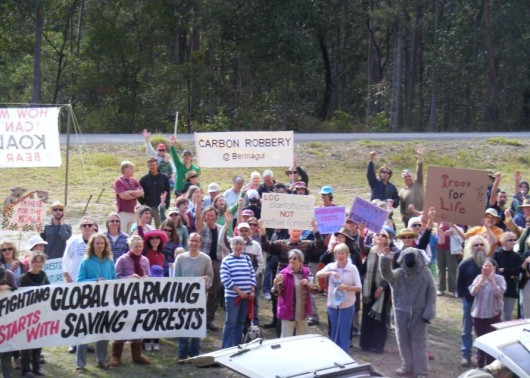 A community morally right to defend habitat and prepared to defend that right A community morally right to defend habitat and prepared to defend that right
.
“They are logging old-growth in Dampier, threatened species habitat in South Brooman, endangered species habitat in Nadgee and now this.”
“The loss of biodiversity coupled with logging and burning means the condition of many forests is as bad as the endangered ecological communities on private land, unable to support most threatened and endangered species and unable to recover.”
“We urge the newly appointed Minister for the Environment, Mr John Robertson, to step in on behalf of the native forests and their dependents and stop these archaic practices.”
“The current government policy of destroying habitat to satisfy ‘wood supply agreements’ is robbing from the future generations their chance of survival. The amount of breaches was astounding and shows that Forests NSW cannot be trusted to log these important areas of Koala habitat.”
“We have inspected many other logging operations in the past year and have found the same breaches everywhere we have looked. This is not a once off mistake but a systemic disgust for any environmental protection measures.”
Conservationists state the native forest logging industry is unsustainable and only propped up by political will, public subsidies and union backing.
Spokesperson for the South East Region Conservation Alliance, Pru Acton, says:
“The significant social and economic costs of reduced biodiversity can only increase while our natural systems are poorly managed.”
“Credible experts agree that the cost of logging this habitat is not only the last few koalas, but also potable water supplies, oysters, the inspiration for the local artists community, and another chunk of the Wilderness Coast’s tourism potential.”
“It seems the NSW Government has now decided its contractual obligations to supply sawlogs locally and woodchips to Asia is more important then protecting this much loved native animal.”
.
South East Region Conservation Alliance
.
Conservationists state the native forest logging industry is unsustainable and only propped up by political will, public subsidies and union backing.
Spokesperson for the South East Region Conservation Alliance, Pru Acton, says: “The significant social and economic costs of reduced biodiversity can only increase while our natural systems are poorly managed.”
“Credible experts agree that the cost of logging this habitat is not only the last few koalas, but also potable water supplies, oysters, the inspiration for the local artists community, and another chunk of the Wilderness Coast’s tourism potential.”
“It seems the NSW Government has now decided its contractual obligations to supply sawlogs locally and woodchips to Asia is more important then protecting this much loved native animal.”
.
[Source: ‘Logging resumes at Bermagui’, by Stan Gorton Narooma News, 20090204 – note the Narooma News has removed this news item online. However, the Narooma News has chosen not to remove its following story (Source: ^http://www.naroomanewsonline.com.au/story/191381/albino-possum-causes-log-truck-roll-over-at-narooma/ if it be not similarly removed].
 Speeding logging trucker blames possum
..Narooma News editor’s reputation shot Speeding logging trucker blames possum
..Narooma News editor’s reputation shot
.
Narooma News spins the following story to appease local logger readership:
.
“In a bizarre set of circumstances, a rare but dead albino possum is believed to have caused a log truck roll-over on the Princes Highway just south of Narooma.
The accident occurred just after 1pm when witnesses said a local from Wallaga Lake stopped to look at the road-kill possum that had been lying on the roadside at the entrance to the Island View Beach Resort.
A series of cars backed up behind the stopped vehicle in the southbound lane. Another Narooma local who was last in the line of stopped cars looked in his rear-vision mirror only to see the huge red-coloured truck coming up fast from behind.
“I think I am going to buy a lottery ticket,” said the local, who at one point thought the truck was going to smash into him and end his life.
The truck driver then allegedly swerved onto the wrong side of the road, narrowly missing the line of cars and while he was fortunate not to face any oncoming northbound traffic, he did lose control on the straight stretch of highway.
The truck reportedly clipped a boat trailer, flipped onto its side, sliding down the highway with the prime mover coming to rest in bushland just off the verge north of the Nangudga Bridge.
An ACT couple who among those first on the scene were able to help the truck driver out of the cab but they said he was badly shaken up and was not aware of where he was.
The Pambula man was the only person injured in the accident and was taken to Moruya Hospital for treatment.
The highway was closed down to one lane with firefighters, police and RMS personnel cleaned up and investigated the scene.
Residents from the nearby Island View caravan park were alerted to the accident by a loud bang and they lined the highway watching the accident.
The accident occurred at the start of the June long weekend where NSW police were out in force urging drivers to be careful on the busy roads.
Albino or golden brush-tailed possums are very rare but there is a known population living in the Narooma area.’
.
~ by the Narooma News editor…and watch out for drop bears too!
.
Meanwhile NSW Forests remains culturally contemptuous to NSW forests
.
Forests NSW recruit their students with Communications degrees to lie for it on its website:
“State forests in NSW are managed sustainably to provide a supply of timber today and into the future, to protect the environmental values of the forest and provide community amenities.”
Forests NSW website claims that “Ecologically sustainable forest management (ESFM) is our guiding philosophy. ESFM is about managing forests to maintain ecological principles and biodiversity while optimising the benefits to the community from all uses of the forest…”
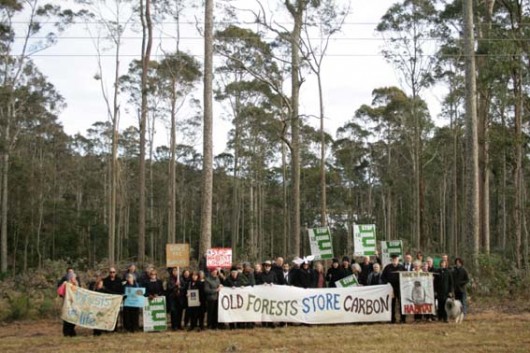 Narooma Community in defence of Koala Habitat
– clearly not convinced about Forests NSW spiel about “optimising the benefits to the community” Narooma Community in defence of Koala Habitat
– clearly not convinced about Forests NSW spiel about “optimising the benefits to the community”
.
Revolving Door politics of NSW Labor
.
In the revolving door politics of NSW Labor, Premier #3 Nathan Rees on 16th November 2009 sacked Ian MacDonald from his DPI Ministry.
Rees was himself sacked as premier on 3 December, then a week later, Labor Premier #4 Kristina Keneally (Labor show pony) reappointed Ian MacDonald ‘Minister for State & Regional Development and Minister for Mineral & Forest Resources‘ in December 2009.
The labelling of Minister for ‘Forest Resources’ left NSW State Forests in no doubt about the death row status. Throughout NSW Labor’s factional power shuffle Macca’s chair never got cold.
The then Minister for Primary Industries , Tony Kelly, overseeing Forests NSW, claimed on 18 November 2009: “The NSW Government has a solid track-record for maintaining prosperous and sustainable primary industries, I will be working hard with industry to ensure this tradition continues.”
.
[Source: Source: NSW Department of Primary Industries, ^http://www.dpi.nsw.gov.au/__data/assets/pdf_file/0019/308251/Minister-Kelly-Visits-Industry-and-Investment-NSW-Headquarters.pdf, since deleted by the NSW Government – the file, not the department unfortunately]
.
Tigerquoll’s Position
.
All State Forests should be added to Australia’a National Park Estate. State Governments and their narrow mindset culture cannot be trusted with ecology. Boral and Nippon Paper can transition their logging operations into plantation-only FSC resources.
The Twofold Bay Woodchip Mill was set up near Eden in 1969 by Daishowa Paper Manufacturing Company has exported and profitted from over 35 million tonnes of Australian native forest woodchips, mostly to Japan, where its parent company is based.
In contributing to the annihilation of thousands of hectares of Australia’s native forest habitat the Daishowa Twofold Bay Woodchip Mill is Australia’s Habitat Auschwitz. It must be unceremoniously closed down immediately.
 Daishowa – Japan’s BIG Corporate Eco-Rapist and BIG Koala Exterminator Daishowa – Japan’s BIG Corporate Eco-Rapist and BIG Koala Exterminator
.
 Boral Spotted Gum – corporate shareholder perspective
. Boral Spotted Gum – corporate shareholder perspective
.
 Spotted Gums too magnificent to kill
[Source: Save Our Water Ways Now, photo by Robert Whyte,
^http://www.saveourwaterwaysnow.com.au/01_cms/details_pop.asp?ID=135] Spotted Gums too magnificent to kill
[Source: Save Our Water Ways Now, photo by Robert Whyte,
^http://www.saveourwaterwaysnow.com.au/01_cms/details_pop.asp?ID=135]
.
Further Reading:
.
[1] South East Region Conservation Alliance, ^http://www.serca.org.au/
.
[2] ‘South East Forests must be protected’, by Greens MP David Shoebridge, 20110629, ^http://davidshoebridge.org.au/2011/06/29/south-east-forests-must-be-protected/
.
‘Greens MP David Shoebridge today met with local campaigners and timber workers in the Bermagui State Forest to get a first-hand view of the impact of continued logging in the South East Forests.

“There is a real concern that this logging is further fracturing the remaining stands of koala habitat in the South East,” Mr Shoebridge said.
“The logging is being undertaken in a nature corridor that links Wallaga Lake National Park and Bermagui Nature reserve. This corridor should be protected.
“With the logging at Bermagui coming within a few hundred meters of town the prospects of more intensive and drier regrowth producing higher levels of fire hazard are real.

“Forests NSW has said that the beautiful “cathedral” entrance to Bermagui will be protected. However on closer inquiry only a small part of the western side and a 50m ‘visual protection zone’ to the east is currently protected.
“In discussions with Forests NSW today they have committed to reviewing the decision on the cathedral to consider protecting all of it from logging. This would be a welcome, if modest, concession.
“The South East Forests are a priceless natural asset and this new State government has a real chance to break with the past and save them from continued logging for wood chips.
“Local campaigners are committed to saving these beautiful forests and this will remain a key focus in the coming years,” Mr Shoebridge said.
.
[Ed: That was over a year ago – our love and commitment for the old forest – we remember ]
.
Tags: Bermagui Community, Bermagui State Forest, Boral, Build something great, Eucalyptus maculata, Forest-Fiddling Loggers, Forests NSW, Grey-Headed Flying Foxes, Ian Macdonald, koala habitat, Kristina Keneally, Logging, Narooma Community, Sapphire Coast, Save the Koala, South East Corner, South East Forest Rescue, Spotted Gum
Posted in Koalas, Possums and Gliders, Quolls, South East Corner (AU), Threats from Deforestation | No Comments »
Add this post to Del.icio.us - Digg
Saturday, January 7th, 2012
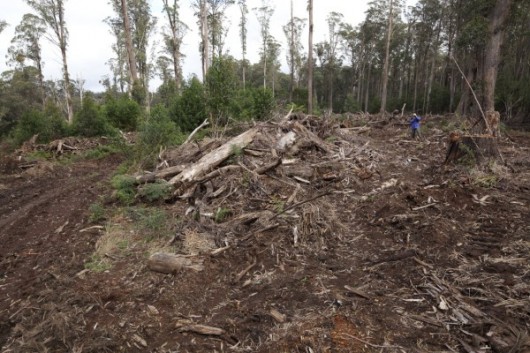 Cathcart State Forest (NSW) being logged in 2011
[Source: Australian Forests and Climate Alliance ^http://forestsandclimate.net/newsouthwales] Cathcart State Forest (NSW) being logged in 2011
[Source: Australian Forests and Climate Alliance ^http://forestsandclimate.net/newsouthwales]
.
Most of Australia’s native vegetation cover, over 75% of that predating the 1788 Colonial Invasion, has been ‘cleared’ – a euphemism for deforested, logged, destroyed, killed.
Today, as one travels around Australia and sees vasts areas of unproductive, degraded, denuded and abandoned farmlands – one questions why destroy more fragile environment? Yet the exploitative bastards are still hell bent on killing more native forest and bushland, even though they can’t properly manage the ‘already ‘cleared’ lands they’ve got. It is a short sighted insatiability, harking to a 19th Century ‘old blighty’ mindset of taming the land. It is deluded thinking that just because the native vegetation is green and looks fertile that it can be replaced for pasture and cropping and that new cleared land will be any different to that already cleared.
The Liberal-Labor governments and their rural National mates haven’t given a toss throughout the entire 20th Century and still couldn’t give a toss.
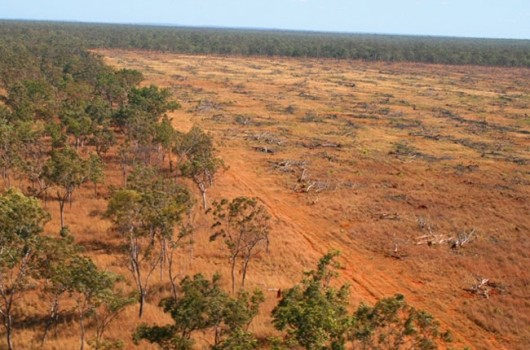 Recent land clearing in the Daly River catchment area
Northern Territory, Australia.
Photo: Environment Centre NT Recent land clearing in the Daly River catchment area
Northern Territory, Australia.
Photo: Environment Centre NT
.
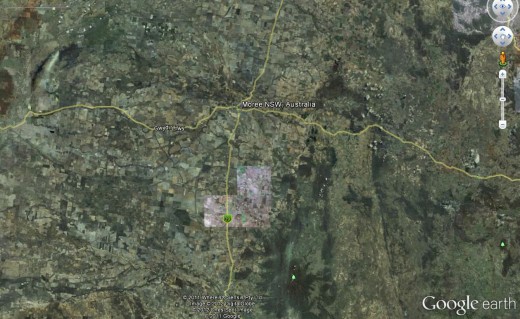 Moree region New South Wales – mainly deforested
Visit Google Earth and zoom into any area of NSW and see that most of it has been deforested
(click image to enlarge) Moree region New South Wales – mainly deforested
Visit Google Earth and zoom into any area of NSW and see that most of it has been deforested
(click image to enlarge)
.
Still across Australia in 2011, thousands of hectares of native forests continue to be deforested – albeit for farming, logging and development, or just bizarre bushfire abandonment. Not only is this occurring on private land, but in State Forests, which most people think are protected. Native forests on land are being cleared branded by State governments as ‘State Forests’ are simply not protected.
The native trees, flora and fauna are not protected from logging, bushfire, State-sanctioned arson (aka ‘hazard reduction‘), State napalming (aka indiscriminate ‘hazard reduction‘), indiscriminate State aerial poisoning with 1080, wildlife poaching, 4WD hooning, trail bike hooning, or even backpacker murdering. The watercourses (and the interconnected groundwater aquifers), that flow through State Forests are not protected from fishing, stormwater run-off, mine tailing contamination, farm pesticide and herbicide, industrial pollution.
.
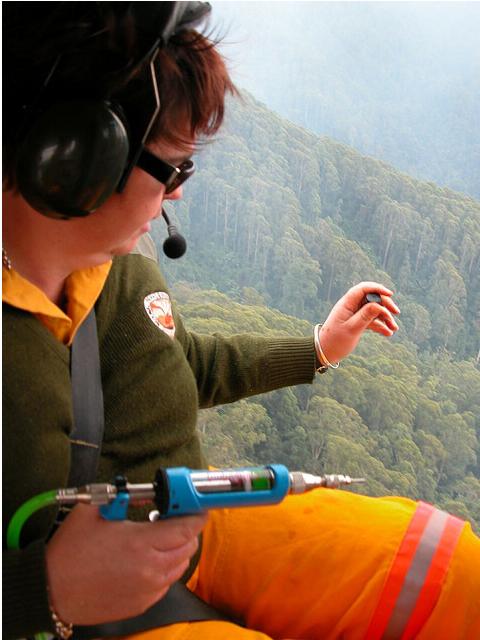 Helicopter Aerial Incendiary
Over Bindarri National Park, 20km south-west of Coffs Harbour, New South Wales
Yes, even our National Parks and Wildlife Service sets indiscriminate fires to National Parks! Helicopter Aerial Incendiary
Over Bindarri National Park, 20km south-west of Coffs Harbour, New South Wales
Yes, even our National Parks and Wildlife Service sets indiscriminate fires to National Parks!
.
For the likes of taxpayer funded government industrial loggers ‘State Forest’ is a euphemism ‘for not logged yet‘. This applies to the likes of Forestry Tasmania, VicForests, Forests NSW, Forestry SA (spot the naming trend), as well as the more aptly Queensland Department of Primary Industries and Fisheries, and likewise the Forest Products Commission of Western Australia.
It seems that doesn’t matter whether there is proof that there is an endangered and protected species such as the Long-Footed Potoroo in the Cann Valley State Forest or Drummer State Forest in Victoria, or protected Koalas in the Murrah/Mumbulla State Forests of New South Wales, or three identified endangered species, the wedge-tailed eagle, the swift parrot and the wielangta stag beetle in Tasmania’s Wielangta State Forests, the Liberal-Labor governments of those States turn a blind eye to deforestation.
It is only when self-funded local communities take the respective government logger to the Supreme Court and win that logging stops momentarily, such as in the recent Victorian Supreme Court case Environment East Gippsland Inc v VicForests [2010] VSC 335. In 2006, the Victorian State Government committed to increasing the conservation parks and reserves within the broader Brown Mountain area. Disregarding its elected master and ignoring any concerns for the ecological Precautionary Principle, State industrial logger VicForests, got stuck in with its mechanical clearfelling of old growth forests in the Brown Mountain area.
Not-for profit group Environment East Gippsland (EEG) self-funded and obtained numerous studies of the area indicated the presence of important threatened and rare species. EEG requested the Minister for Environment and Climate Change, Gavin Jennings, to make an interim conservation order to conserve critical habitat of the endangered Long-footed Potoroo, Spotted-tailed Quoll, Sooty Owl, Powerful Owl and Orbost Spiny Crayfish at Brown Mountain. Even then, the Minister for Environment and Climate Chang did not grant a conservation order, but instead increased the conservation area surrounding Brown Mountain. It took the overriding legal authority of the Supreme Court to stop the Victorian Government and its delinquent logger trashing protected old growth habitat.
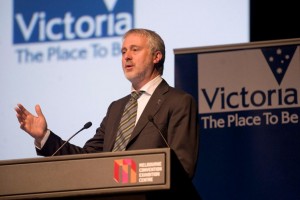 Victorian Labor Minister for Environment (etc), 2007-2010 Victorian Labor Minister for Environment (etc), 2007-2010
.
In March 2010, Forests NSW began controversial logging operations in the Mumbulla State Forest, south of Bermagui on the state’s far south coast. Despite being criticised, after a recent survey identified the forest as a key colony for the region’s remaining koala population, Forests NSW Regional Manager Ian Barnes says the logging must go ahead across 240 hectares of the forest, in order to satisfy a supply agreement with the timber industry.
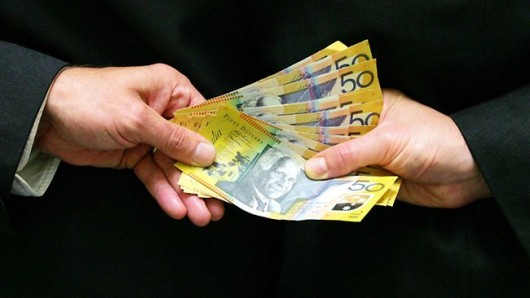 Deforestation is all about lining ones pockets out of ecological wanton exploitation
It’s a ‘wam bam thank you mam’ approach no different to what the Vikings did to the British in the eight Century.
Colonial Australians and their descendants are doing the same to Australian ecology in the 19th, 20th and 21st Centuries. Deforestation is all about lining ones pockets out of ecological wanton exploitation
It’s a ‘wam bam thank you mam’ approach no different to what the Vikings did to the British in the eight Century.
Colonial Australians and their descendants are doing the same to Australian ecology in the 19th, 20th and 21st Centuries.
Mr Barnes says the logging will not affect the koala habitat. “We’ve taken quite some effort to avoid any possible conflict there,” he says. “As anybody who reads the recent report will know, the koalas have been found in the eastern side of the forest, and our logging is planned for the western part, as far away as we can get from the koalas.”

Despite assurances, anti-logging campaigners have organised a vigil in the forest in an attempt to stop the logging. Conservationist Prue Acton says the activity will devastate the koala population.
“Why risk the only healthy koala colony left in the far south coast. For what? “ she said. “95% of what is going to be logged is going to end up at the Eden woodchip mill, be shipped to Japan for cheap copy-paper. What a disgrace.”
The Greens MP Lee Rhiannon says the Premier should put the protection of koalas ahead of the interests of logging companies. “The New South Wales Government has refused to end logging in the south east native forest but they should step in and stop the destruction of the koala habitat,” she said.
[Source: ‘Logging begins near key koala habitat‘, ABC, 20100330, ^http://www.abc.net.au/news/stories/2010/03/30/2859615.htm?site=southeastnsw]
.
‘Loggers are clearing bushland at rising rate‘
[Source: ‘Loggers are clearing bushland at rising rate’, by Ben Cubby, Sydney Morning Herald, 20111221, ^http://www.theherald.com.au/news/national/national/general/loggers-are-clearing-bushland-at-rising-rate/2399764.aspx?storypage=0]

The amount of bushland being cleared by logging in NSW soared last year to the highest level since state-wide records began in 1988. An area equivalent to 138,400 football fields was cleared for crops, forestry or infrastructure, says a government report.
The Office of Environment and Heritage said the rise in logging was probably cancelled out by regrowth, leading to no net loss of trees, though its most recent survey took place in 2008, before the land clearing spike. It said the reasons for the logging increase were unclear.
”[The] most likely factors relate to market demand and favourable climatic conditions and [they] can be expected to fluctuate over time,” a department spokesman said. ”It is also possible that recent changes in forestry methods are more readily detectable by satellite monitoring.”
Environment groups said the annual vegetation report was evidence that logging companies were operating in an unrestrained manner.
Bushfires remain the biggest destroyer of forests in the state, leading to a net loss of 48,300 hectares in 2010, the report said.
.
But logging activities now come a close second, accounting for the removal of 42,700 hectares of trees in 2010. This is up from 31,000 hectares the previous year, and an average of about 21,000 hectares a year since 1988.
About 21,200 hectares of bushland was cleared in 2010 to make new areas for crops and grazing, while 5300 hectares were cut down to make way for roads, factories and housing.
”The NSW government is currently conducting a review of native vegetation controls,” said the chief executive of the Nature Conservation Council of NSW, Pepe Clarke. ”They should take this report as a warning – what is required are stronger land- clearing laws that do more to protect the environment, not weaker ones.”
The Wilderness Society said the government had ”failed in its promises to restrain land clearing, resulting in rapid and accelerating degradation of wildlife habitat and water catchments.”
The most recent State of the Environment report found that there had been no net loss of ”woody cover” across NSW between 2003 and 2008.
”This is because, although clearing has occurred over that period, there has also been an equivalent amount of regrowth including government sponsored environmental and forestry planting programs conducted by private landholders and state forests, within crown forests areas,” the department said.
”Notwithstanding no net loss over the whole state, some regions have experienced net declines in woody cover.”
The report uses the international definition of ”woody cover”, which includes land at least 20% covered by the crowns of trees higher than 2 metres, a description which would include relatively open country.
The introduction of a satellite monitoring system for land clearing last year appears to have increased the level of prosecution for illegal land clearing on private property. On crown lands, the number of prosecutions has increased threefold, from a low base, since 2007.
In 2010, the government received 471 reports of suspected illegal land clearing.
.
‘Landowners sent satellite images identifying land clearing‘
[Source: ‘Landowners sent satellite images identifying land-clearing’, NSW Department of Environment (etc), Media release: 14 May 2010, ^http://www.environment.nsw.gov.au/media/DecMedia10051404.htm]
.
NSW Department of Environment Climate Change and Water (DECCW) today began a high tech education campaign to encourage compliance with native vegetation laws by sending letters to landholders including before and after satellite pictures identifying land clearing.
DECCW Director-General Lisa Corbyn said the letters were part of an ongoing education program to encourage compliance with the laws and inform landowners of the proper channels available to them if they want to clear native vegetation.
“We’ve been using satellite technology for some time to identify changes in vegetation cover that may warrant further investigation,” Ms Corbyn said.
“Now we are also using the technology as an education tool. From today, advisory letters will be sent to landowners including before and after satellite pictures showing that vegetation has been cleared on their land.”
Ms Corbyn said the letters aim to inform to the landowner that the satellite imagery has picked up that vegetation had been cleared and highlight the proper channels available to them under the legislation to allow clearing of native vegetation, such as property vegetation plans.
The letters support other tools used by DECCW to encourage compliance with the legislation, including strategic investigations, prosecutions, penalty notices, stop work orders, remedial directions, warning and advisory letters.
The letter also alerts landowners to incentive funding available to restore and protect native vegetation on their properties.
The Native Vegetation Act was introduced in 2003 to bring an end to broadscale land-clearing in NSW. Since then, more than 400,000 hectares of native vegetation has been conserved or rehabilitated on private land through property vegetation plans (PVPs) and 1.6 million hectares has been managed for thinning and invasive native scrub management.
.
Over 60 % of the native vegetation in NSW has been cleared, thinned or substantially disturbed.
.
The impacts of native vegetation clearing have included the extinction of 77 plant and animal species, soil erosion, increased dryland salinity and a decline in water quality.’
.
2003: ‘Clearing rate in NSW 116,000 to 216,000 hectares per year: NSW Govt report’
[Source: ‘Clearing rate in NSW 116,000 to 216,000 hectares per year: NSW Govt report’, by Stephanie Peatling, Environment Reporter, Sydney Morning Herald, 20031117, ^http://www.sydneyalternativemedia.com/id64.html]
.
The equivalent of up to 200,000 football fields may be illegally stripped of native trees and grass each year in NSW, figures suggest.
The first estimates on the extent of the clearings, which the Department of Natural Resources field staff prepared for the Government’s vegetation taskforce, suggest the figure could be as high as 100,000 hectares a year. The figures show between 150,000 hectares and 560,000 hectares were illegally cleared between 1997 and 2002.
The advice is the first official guess at NSW’s illegal clearance levels. The highest rates are in the Barwon, Central West and Far West regions where much of NSW’s remaining native vegetation is located.
The figures have shocked environmentalists, who stress the urgency of making changes to the state’s natural resource management system, which Parliament is debating this week.
A Wilderness Society campaigner, Francesca Andreoni, said: “The new system needs to be fair to everyone, particularly farmers doing the right thing.
“The shocking extent of illegal clearing confirms the urgent need for the Government to implement its decision to end broadscale clearing.”
Figures recording the rate of illegal land clearing each year are almost impossible to compile because it so hard to charge people who breach native vegetation laws. There is also a complicated system of exemptions which allow people to clear land for purposes such as maintaining fire access trails.
Monitoring illegal clearing is potentially dangerous for departmental compliance officers. After reports of illegal clearing earlier this year on a property near Nyngan, in the state’s west, department officers were prevented from entering the property by an angry crowd of up to 150 people.
.
When the amount of land illegally cleared is added to land that is legally approved for clearance, the department estimates between 700,000 hectares and 1.3 million hectares of land were cleared between 1997 and 2002.
.
The figures suggest clearing was faster than the Department of Natural Resources’ previously admitted figure of about 60,000 hectares a year. That figure would give NSW the second-highest clearing rate in the country behind Queensland.
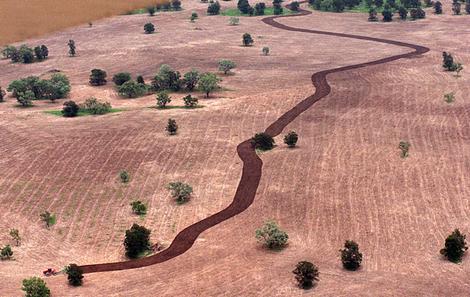
Debate on the Government’s package to overhaul native vegetation laws, based on an election promise to end broad-scale clearing, will take place this week. Last month the Premier, Bob Carr, announced a $406 million deal between farmers and environmentalists to end broad-scale clearing.
Most of the money is expected to go towards such things as tree planting and fencing waterways to help counter salinity and erosion. But local authorities may also compensate farmers for not clearing land. Clearing will still be allowed where it is deemed environmentally necessary.
Under the new system, natural resource management is being overhauled. Thirteen catchment management authorities will replace 19 catchment management boards, 20 regional vegetation committees and 33 water management committees.
Scientists often name land clearing as one of Australia’s most urgent environmental concerns. It contributes to soil salinity, loss of biodiversity and greenhouse gas emissions because carbon dioxide is released into the atmosphere when the cleared timber is disposed of, usually through burning.
.
‘Green groups attack logging growth’
[Source: ‘Green groups attack logging growth’, by David Bancroft, My Daily News, 20111229, ^http://www.mydailynews.com.au/story/2011/12/29/green-groups-attack-logging-growth/]
.
Environment groups have banded together to criticise the level of logging occurring in New South Wales. The Nature Conservation Council, The Wilderness Society, National Parks Association, the Northern Inland Council for the Environment and the North Coast Environment Council have issued a joint warning that iconic and endangered species are being threatened by land clearing.
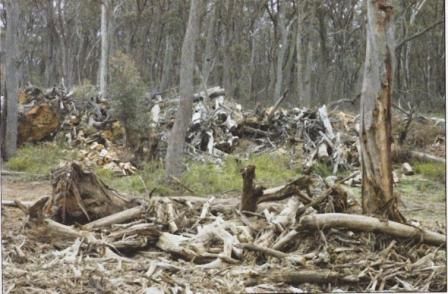 Illegal deforestation for fire wood, near Taralga, on the western edge of the Blue Mountains
Source: ^http://www.orchidsaustralia.com/article_%20conservation_no3.htm Illegal deforestation for fire wood, near Taralga, on the western edge of the Blue Mountains
Source: ^http://www.orchidsaustralia.com/article_%20conservation_no3.htm
.
In a joint press release, the groups said the NSW annual report on native vegetation released by the Office of Environment and Heritage (Ed. yet another money wasting name change) this month showed 2009/10 was the “worst year on record for clearing of native bushland”.
.
The Wilderness Society campaigns manager Belinda Fairbrother said the report showed that in 2009/10 an area equating to 138,400 football fields was cleared for crops, forestry or infrastructure.
.
“This is higher than any other year since records commenced in 1988 and shows the NSW Government has failed in its promises to restrain land clearing, resulting in rapid and accelerating degradation of wildlife habitat and water catchments,” she said.
North Coast Environment Council president Susie Russell said the report made a sad end to the International Year of Forests.
“The area cleared for forestry in 2009/10 was almost five times greater than it was in 1988/89,” she said.
“It reveals a massive increase in the rate and intensity of logging in NSW, which will be causing untold damage to the extraordinary high diversity forests of north-east NSW.”
Nature Conservation Council chief executive officer Pepe Clarke said land clearing was recognised as the single greatest threat to wildlife in Australia.
“It causes the death of birds and animals, the extinction of species, leads to the poisoning of soils from salinity and makes a major contribution to global warming,” he said.
.
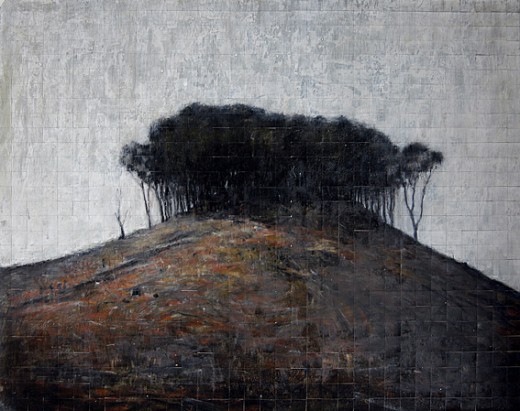 The Liberal-Labor Party ‘Island Vision’ for Australia’s State Forests
‘The Hill’ (Penrose State Forest, NSW) 2007, drawing by James King The Liberal-Labor Party ‘Island Vision’ for Australia’s State Forests
‘The Hill’ (Penrose State Forest, NSW) 2007, drawing by James King
^http://www.jamesking.com.au/drawings.html
.
Tags: 1788 Colonial Invasion, Cathcart State Forest, deforestation, Eden woodchip mill, fire wood, Forests NSW, Google Earth, hazard reduction, Helicopter Aerial Incendiary, Island Vision for Australian State Forests, koala habitat, land clearing, Logging, Long-footed Potoroo, Murrah/Mumbulla State Forests, not logged yet, Orbost Spiny Crayfish, Powerful Owl, precautionary principle, Sooty Owl, spotted-tailed quoll, State-sanctioned Arson, VicForests, Wielangta State Forests
Posted in Koalas, Owls, Quolls, Threats from Bushfire, Threats from Deforestation, Threats from Farming | No Comments »
Add this post to Del.icio.us - Digg
|
|
 Ecological consultant David Paul with a koala found in the Leard State Forest
[Source: Photo by Tania Marshall, Front Line Action on Coal,
^http://frontlineaction.wordpress.com/]
Ecological consultant David Paul with a koala found in the Leard State Forest
[Source: Photo by Tania Marshall, Front Line Action on Coal,
^http://frontlineaction.wordpress.com/]
 Maules Creek Mine location map
[Source: Google Maps]
Maules Creek Mine location map
[Source: Google Maps]
 The Leard State Forest
An isolated remnant box woodland
The Leard State Forest
An isolated remnant box woodland
 Box Woodland decimated for industrial scale cotton
The farming model is entirely artificially dependent river-diverted irrigation for export produce.
[Source: Promotional tourism advertisement by the NSW Government,
^http://www.visitnsw.com/destinations/country-nsw/moree-and-narrabri-area/gallery]
Box Woodland decimated for industrial scale cotton
The farming model is entirely artificially dependent river-diverted irrigation for export produce.
[Source: Promotional tourism advertisement by the NSW Government,
^http://www.visitnsw.com/destinations/country-nsw/moree-and-narrabri-area/gallery]
 Leard State Forest location map
[Source: Google Maps]
Leard State Forest location map
[Source: Google Maps]
 Koala in Leard State Forest
[Source: Photo by Tania Marshall, Front Line Action on Coal,
^http://frontlineaction.wordpress.com/]
Koala in Leard State Forest
[Source: Photo by Tania Marshall, Front Line Action on Coal,
^http://frontlineaction.wordpress.com/]
 Nearby Boggabri Open Cut Coal Mine, owned by Whitehaven Coal
Saw thousands of hectares of native Box Woodland bulldozed in 2006.
Nearby Boggabri Open Cut Coal Mine, owned by Whitehaven Coal
Saw thousands of hectares of native Box Woodland bulldozed in 2006.
 (Click icon and play audio on the ABC Radio website, turn up volume to listen)
[Source: ‘Concern for Koala’s in the Leard State Forest’, 20121112, radio interview by Kelly Fuller, Morning Show, ABC Radio New England NSW,
^http://www.abc.net.au/local/audio/2012/11/12/3630754.htm]
(Click icon and play audio on the ABC Radio website, turn up volume to listen)
[Source: ‘Concern for Koala’s in the Leard State Forest’, 20121112, radio interview by Kelly Fuller, Morning Show, ABC Radio New England NSW,
^http://www.abc.net.au/local/audio/2012/11/12/3630754.htm]
 Community protest meeting against local coal mining
[Source: ‘Sea of hands support gasfield free region at Tamworth public meeting’, 20130226,
^http://maulescreek.org/news/page/3/]
Community protest meeting against local coal mining
[Source: ‘Sea of hands support gasfield free region at Tamworth public meeting’, 20130226,
^http://maulescreek.org/news/page/3/]













 1927 ‘Black August’
When 600,000 Koalas were shot and skinned across Queensland
1927 ‘Black August’
When 600,000 Koalas were shot and skinned across Queensland




































































